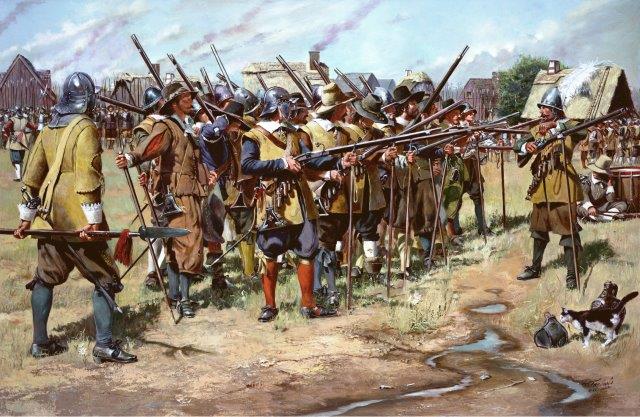 The First Muster by Don Troiani for the state of Massachusetts, 1637.
The First Muster by Don Troiani for the state of Massachusetts, 1637.
The history of the National Guard began on December 13, 1636, when the General Court of the Massachusetts Bay Colony ordered the organization of the Colony's militia companies into three regiments: The North, South and East Regiments. The colonists had adopted the English militia system which obligated all males, between the ages of 16 and 60, to possess arms and participate in the defense of the community.
The early colonial militia drilled once a week and provided guard details each evening to sound the alarm in case of attack. The growing threat of the Pequot Indians to the Massachusetts Bay Colony required that the militia be in a high state of readiness. The organization of the North, South and East Regiments increased the efficiency and responsiveness of the militia.
Although the exact date is not known, the first muster of the East Regiment took place in Salem, Massachusetts. The National Guard continues its historic mission of providing units for the first-line defense of the nation. The 101st Engineer Battalion, Massachusetts Army National Guard, continues the East Regiment's proud heritage of 350 years of service.
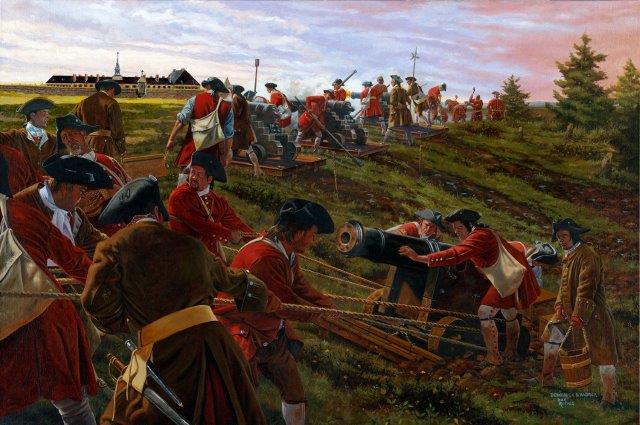
The Siege of Louisbourg by Domenick D'Andrea and Rick Reeves for the states of Massachusetts, Connecticut, Rhode Island and New Hampshire, 1745.
Throughout the 18th century, Britain and France squared off in a succession of conflicts to determine which country would be the world’s leading military and colonial power. In 1744, what became known as “the War of Austrian Succession” broke out between the two countries and their colonies in North America quickly became involved. The French began construction of a large garrison at Louisbourg, located in the colony of Ile Royale (known also as Cape Breton), now part of the Canadian province of Nova Scotia.
British subjects in the New England colonies of Massachusetts, New Hampshire, Connecticut, and Rhode Island fished extensively in the “Grand Banks” off Newfoundland and Nova Scotia. The French military sought to limit this activity and reassert power over colonial lands lost earlier to the British. Conflict ensued in North Atlantic waters, as the French soldiers and sailors destroyed British fishing equipment on the remote island of Canso, and French naval patrols harassed New England shipping.
Frustrated, the colonial governors of Massachusetts and New Hampshire issued a call for volunteers to take the Louisbourg fortress. By the spring of 1745, the New England colonies had raised an army of 4,000 men from their militias and procured vessel s to transport them to Louisbourg. Commanded by Colonel William Pepperrell of Massachusetts, British Royal Navy sailors also aided in the effort. Arriving at Cape Breton in May 1745, the colonists set up camps and moved artillery pieces by sled over muddy, marshy terrain in order to besiege the Louisbourg fortress. These militiamen soon established artillery batteries, effectively attacking the fortification while receiving little return fire from the French. The colonial force drew down French supply lines and forced the capitulation of the army by June 26, 1745. Much of the sacrifice on the part of colonial militia during the siege was due to the numbers who died from disease due to unsanitary conditions in their encampment, but despite the toll on the colonial militiamen, they nevertheless won a tactical victory for the British crown.
The New Englanders’ victory was short-lived, however, as the British decided to return the fortress in 1748 to the French through the Treaty of Aix-la-Chapelle, which ended the War of Austrian Succession. The colonists were angry and resentful that geopolitical events far from North America had overshadowed their hard-won victory. This grievance against the British government held in New England for a generation, and thirty years after the siege, veterans of Louisbourg fought against the British Army at Lexington and Concord. Thus, the Siege of Louisbourg, and what the colonists perceived as the British government’s indifference to their military sacrifice, was one of the first in a long series of events which would eventually lead to the Revolutionary War.
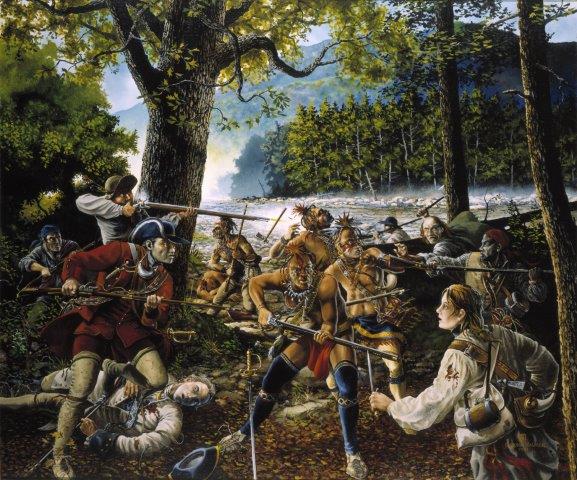 Twenty Brave Men by Jackson Walker for the state of West Virginia, 1756.
Twenty Brave Men by Jackson Walker for the state of West Virginia, 1756.
During the 18th century, Britain and France were engaged in an almost continuous struggle to see which nation would be the world's dominant military power. Wars between the two spilled over to their North American colonies. By the middle of the century the great prize, claimed by both sides, was the Ohio Valley. If France could successfully hold it as part of Canada, the 13 English colonies would not be able to expand west of the Appalachian mountains. In 1755, Britain sent troops to drive the French from the Ohio country.
But Major General Edward Braddock's force of 2,000 British regulars and Virginia militia was ambushed and routed by a French force which included 650 Ottawa and Potawatamie Indians. Braddock's disastrous defeat left the British frontier undefended. The French organized their Indian allies into raiding parties led by French officers, spreading death and destruction throughout the Pennsylvania and Virginia frontier.
In Virginia, hundreds of terrified settlers in the northern Shenandoah Valley fled east; those that remained gathered together in fortified houses or log forts. Militia officers were sent west to organize the settlers for defense and recruit for the regiment of full-time troops which would serve with the British Regulars. In the spring of 1756, Captain Jeremiah Smith of Albermarle County arrived in Hampshire County, Virginia, then on the western edge of settlement and today part of West Virginia.
He was just in time: "...a party of about 50 Indians, with a French captain at their head, crossed the Allegheny Mountains...Capt. Jeremiah Smith raised a party of twenty brave men, marched to meet this...foe, and fell in with them at the head of the Capon River, when a fierce and bloody battle was fought. Smith killed the captain with his own hand; five other Indians have fallen...they gave way and fled." Episodes such as this were repeated scores of times in the frontier counties of what is now West Virginia, which also supplied recruits for the full-time Virginia Regiment. The spirit of these citizen-soldiers of the French and Indian War is carried on today by the men and women of the West Virginia Army National Guard.
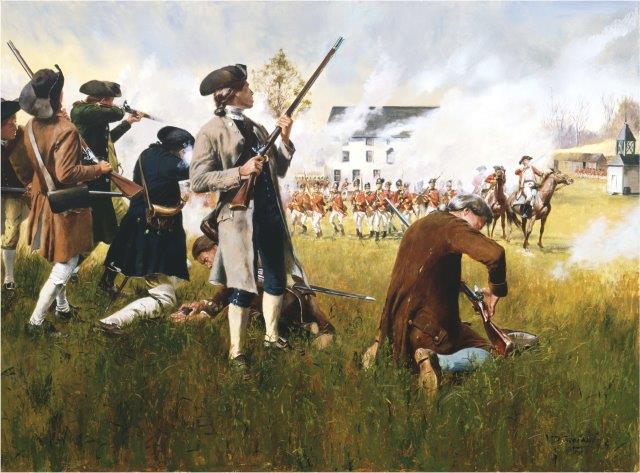 Stand Your Ground by Don Troiani for the state of Massachusetts, 1775.
Stand Your Ground by Don Troiani for the state of Massachusetts, 1775.
In the early hours of April 19, 1775, Capt. John Parker was alerted to mobilize the Lexington Company of the Middlesex County Brigade, Massachusetts Militia, in anticipation of a British 700-man force that was marching to Concord to capture provincial arms. By 2 a.m. Parker had mustered his company on the Lexington Green. The Lexington Company of militia was typical of the period.
The youngest militiaman was 18, the oldest 63; eight fathers and sons served together. Most were farmers, while some were veterans of the French and Indian War. Just after sunrise Parker and his 77 militiamen stood in defiance of the British advance guard. "Stand your ground," Parker ordered. "Don't fire unless fired upon. But, if they want to have a war, let it begin here." Maj. John Pitcairn, commander of the British advance guard, ordered the militiamen to lay down their arms.
Realizing that his company was outnumbered, Parker ordered his men to disperse. As the militiamen began to break ranks, a British officer fired his pistol. Without orders, the British troops opened fire. Although greatly outnumbered, the militiamen returned the fire. The battle went on for several minutes, all around the Green. When it was over, eight Americans lay dead and nine were wounded. The British quickly resumed their march. Later that morning, Capt. Parker reorganized his unit and marched to Concord.
The Lexington Company would later fight in the Battle of Bunker Hill and form a company for service in the Continental Army. However, few of its members on that fateful April morning realized that the Battle of Lexington would lead to the Revolutionary War and American independence. The Lexington Company and the Middlesex County Brigade are perpetuated by the 181st and 182nd Infantry Regiments, Massachusetts Army National Guard.
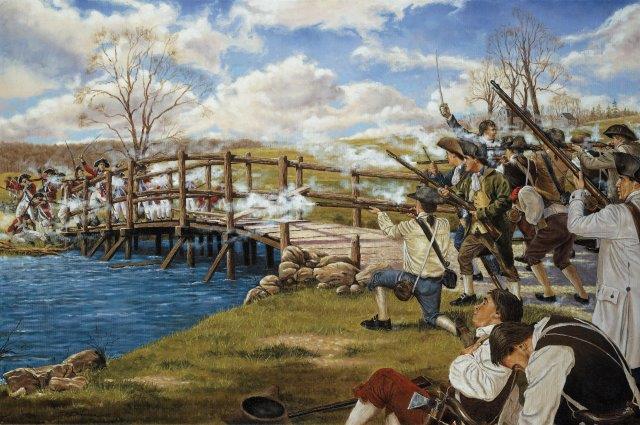 The Shot Heard 'Round the World by Domenick D'Andrea for the state of Massachusetts, 1775.
The Shot Heard 'Round the World by Domenick D'Andrea for the state of Massachusetts, 1775.
At dawn on April 19, 1775, as 700 elite British soldiers marched toward Concord, they fought a brief skirmish with militiamen on Lexington Green, leaving eight colonists dead and nine wounded. The King's troops marched on, arriving at Concord two hours later. While some troops searched the town for stores of gunpowder and arms, three companies guarded the "North Bridge." As the British were marching toward Concord, word spread of the fight at Lexington. Alarm bells rang calling out the militia and Minute Men across Middlesex County. Among the units to muster was Colonel James Barrett's Middlesex County Regiment of Minute Men. Once in formation the regiment moved onto a hill within 500 yards of where the British stood watch at North Bridge.
Colonel Barrett, needing to organize additional militia companies, left his command to Major John Buttrick. When smoke appeared in the sky above Concord the Americans wrongly believed the British were burning the town. In response Buttrick decided to move his men toward the town. As the Americans advanced the British pickets fell back across the bridge. The last British unit to cross, the Light Company of the 4th (King's Own) Foot, stopped to tear up some of the planks to delay the militia advance. Leading the American column was Captain Isaac Davis's Company of Minute Men from Acton. As they got within 50 yards of the bridge Buttrick shouted at the British to stop tearing up the planks.
Suddenly three British shots were fired, killing Davis and another man instantly and wounding a third. Buttrick shouted "Fire! For God's sake Fire!" and the Minute Men unloosed a ragged but heavy volley. Four out of eight British officers were hit along with seven enlisted men, two of whom died. The British immediately fell back toward the town where they linked up with other Royal troops. Buttrick moved his men across the bridge as the British column began marching back down the road toward Boston. Militiamen gathered along their path and soon began firing from behind trees and stone walls, inflicting an ever-increasing number of casualties. When the exhausted British troops reached Lexington, scene of the fight earlier that morning, they were met by a relief force sent to accompany them back to Boston.
However, the Americans did not stop their attacks, inflicting additional losses on the British column before it reached Boston. In total the British suffered almost 300 dead, wounded or missing. Within days an army of nearly 20,000 militiamen from all over New England surrounded the city, effectively putting it under siege. In 1875, on the 100th anniversary of the action at Concord, Daniel Chester French's Minuteman statue, the symbol of today's National Guard, was dedicated. As part of the ceremony, Ralph Waldo Emerson's poem The Concord Hymn was read honoring the men who "fired the shot heard round the world" which began the Revolutionary War. Today's National Guard is the direct descendent of those militia and Minute Men who stood their ground to protect their homes and freedoms.
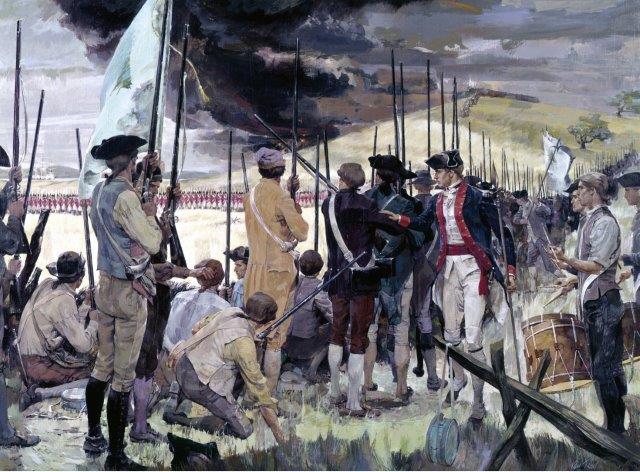 The Whites of Their Eyes by Ken Riley for the state of Massachusetts, 1775.
The Whites of Their Eyes by Ken Riley for the state of Massachusetts, 1775.
Along the battle line on Breed's Hill and extending to the Mystic River (destined to go into history books as "The Battle of Bunker Hill"), the colonial militiamen coolly held their fire as seven crack regiments of the British Army, the best infantry in the world, advanced toward them. Up from the Charlestown landings came the red-coated enemy, anticipating an easy victory.
An officer sternly admonished the militiamen, "Do not fire until you see the whites of their eyes!" With magnificent discipline and courage, they waited . . . fired . . . and thus began the War for Independence. The American militia proved to the world that civilian volunteers could be molded into trained fighting men, thus forging the high tradition of the National Guard in our armed forces.
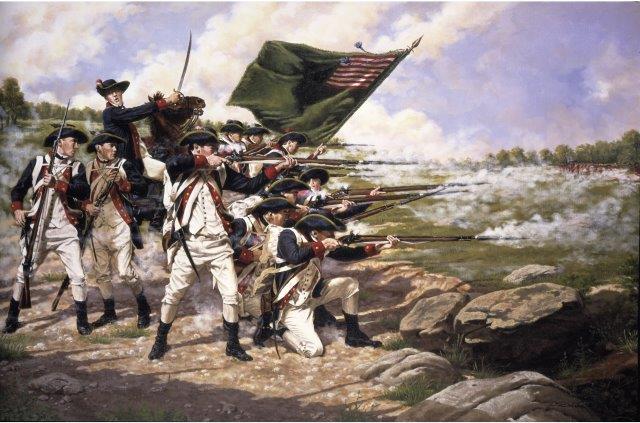 The Battle of Long Island by Domenick D'Andrea for the state of Delaware and Maryland, 1776.
The Battle of Long Island by Domenick D'Andrea for the state of Delaware and Maryland, 1776.
Colonel Henry "Light-Horse Harry" Lee, a hero of the Revolutionary War and father of Robert E. Lee, once commented that during the war "the state of Delaware furnished one regiment only; and certainly no regiment in the army surpassed it in soldiership." At the Battle of Long Island, the actions of the Delaware Regiment kept the American defeat from becoming a disaster. Indeed, the soldiers from tiny Delaware, fighting alongside the 1st Maryland Regiment, may well have prevented the capture of the majority of Washington's army, an event which might have ended the colonial rebellion then and there.
Organized in January, 1776 by Colonel John Haslet, the Delaware Regiment was noteworthy from the start as the best uniformed and equipped regiment of the Continental Army. Their blue jackets with red facings and white waistcoat and breeches would later become the uniform for all the Continental troops. During the Battle of Long Island, the Delaware and Maryland troops were positioned on the right of Washington's line, defending the most direct route from the British landing site in south Brooklyn to the American fortifications in Brooklyn Heights.
Though they faced the fiercest fighting of the day, they held their ground, allowing the remainder of Washington's army to retreat to the safety of the fortifications. When they in turn were outflanked and forced to retreat, the Delaware Regiment conducted an orderly retreat through marshland and across the Gowanus creek, carrying off with them 23 prisoners. Two nights later, Washington entrusted his Delaware and Maryland soldiers to be the rear guard as he secretly withdrew his army from Brooklyn to Manhattan. Today, the 175th Infantry Regiment, Maryland Army National Guard, preserves the legacy of the 1st Maryland Regiment. The 198th Signal Battalion, Delaware Army National Guard, perpetuates the proud lineage of the Delaware Regiment
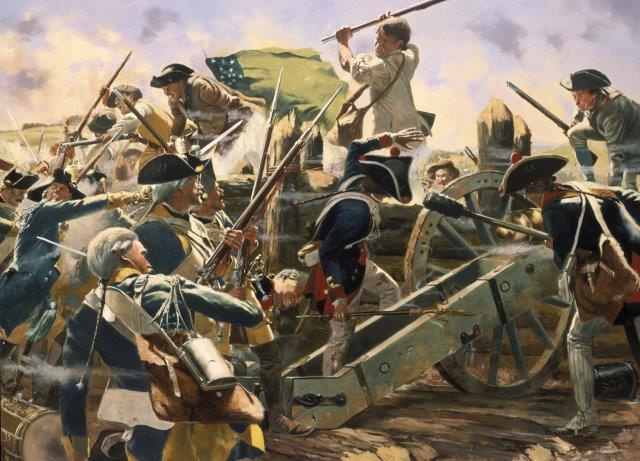 The Battle of Bennington by Don Troiani for the states of Vermont and New Hampshire, 1777.
The Battle of Bennington by Don Troiani for the states of Vermont and New Hampshire, 1777.
In the spring of 1777 a British Army under General John Burgoyne started down the Hudson River from Canada. As Burgoyne marched south, patriot militia began to gather in Vermont and New Hampshire. John Stark, a veteran soldier, was given command of the 1500-man New Hampshire Brigade. Hearing that Burgoyne was planning a raid into Vermont, Stark marched his men to Bennington.
There they were joined by militia regiments from Vermont and western Massachusetts. On August 11, Burgoyne sent out a mixed force of some 800 Canadians, Loyalists, Indians, British, and Hessian (German) mercenaries on a foraging expedition. This mostly-German force was harassed by small bands of militia, and its Hessian commander sent for reinforcements; he stopped to await them a few miles from Bennington.
With the enemy force position on and around a large hill, General Stark decided to use his 2,000 militiamen to surround them. "Yonder are the Redcoats," Stark is supposed to have said. "We will defeat them or Molly Stark will sleep a widow tonight." Small bands of militiamen, pretending to be loyal Tories, worked their way behind enemy positions. When firing began, these men turned on the Hessians and Tories around them. Those not killed fled into the woods, pursued by the militiamen.
Other Americans surged up the hill to the Hessian breastworks, and for two hours the battle raged. Hessian commander was mortally wounded when, ammunition exhausted, he and his Dragoons attempted to hack their way off the hill with their swords. When the battle was at its height, reinforcements arrived from Burgoyne. Luckily, the Vermont militia came up or about the same time to reinforce Stark, and again the fighting raged. American victory was assured when the militiamen drove off the Hessian reinforcements. The proud traditions of the militia who fought so well at Bennington are today carried on by units of New Hampshire and Vermont Army National Guard.
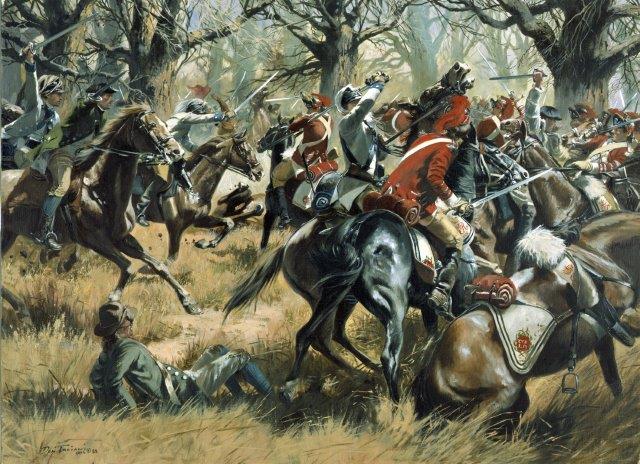 The Battle of Cowpens by Don Troiani for the states of South Carolina, North Carolina, Virginia, Maryland and Delaware, 1781.
The Battle of Cowpens by Don Troiani for the states of South Carolina, North Carolina, Virginia, Maryland and Delaware, 1781.
In upland South Carolina, at a place where local farmers penned their cows, an American force of 300 Continentals and 700 militia from North and South Carolina, Virginia, and Georgia, won a brilliant victory against the British. On January 16, Brigadier General Daniel Morgan, pursued by 1,100 British under Lt. Col. Banastre Tarleton, carefully picked his ground for a defensive battle.
That night, Morgan personally went among the Continentals and militiamen to explain his plan of battle. Morgan wanted two good volleys from the militia, who would then be free to ride away. The next day, the battle went very much as Morgan had planned. Georgia and North Carolina sharpshooters, in front of the main body of American militia, picked off British cavalrymen as they rode up the slight rise toward the Americans.
Then the deadly fire of the main body of South and North Carolina militia forced Tarleton to commit his reserves. Seeing the militia withdrawing as planned, the 17th Light Dragoons pursued, but were driven off by Morgan's cavalry. Meanwhile, the British infantry, who assumed that the Americans were fleeing, were hit by the main body of Continentals, Virginia militiamen, and a company of Georgians. At the battle's end they were aided by militia troops, who, instead of riding away as planned, attacked the 71st Highlanders, who were attempting to fight their way out of the American trap.
The British lost: 100 killed including 39 officers, 229 wounded, and 600 captured. As they fled the field, Tarleton and his dragoons were pursued by Colonel William Washington's cavalry, which included mounted Georgia and South Carolina militiamen. The Continentals who fought at Cowpens are perpetuated today by the 175th Infantry, Maryland Army National Guard, and the 198th Signal Battalion, Delaware Army National Guard, and the Virginia militia by the 116th Infantry, Virginia Army National Guard. The heritage of the rest of the American troops who fought in this "greatest tactical victory ever won on American soil" is carried on today by the Georgia, South Carolina and North Carolina Army National Guards.
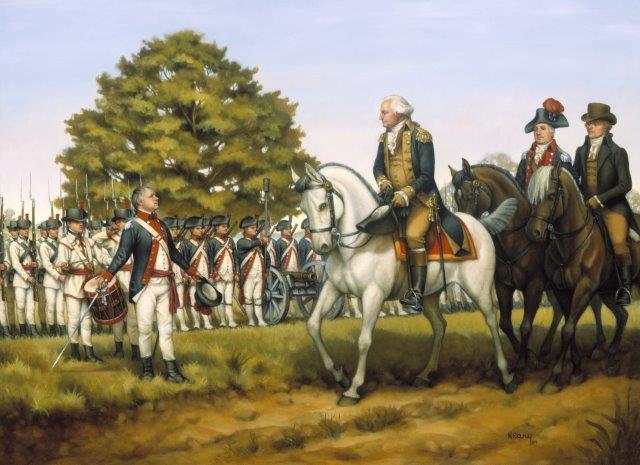 To Execute the Laws of the Union (The Whiskey Rebellion) by Donna Neary for the states of Pennsylvania, New Jersey, Maryland and Virginia, 1794.
To Execute the Laws of the Union (The Whiskey Rebellion) by Donna Neary for the states of Pennsylvania, New Jersey, Maryland and Virginia, 1794.
In September 1791 the western counties of Pennsylvania broke out in rebellion against a federal excise tax on the distillation of whiskey. After local and federal officials were attacked, President Washington and his advisors decided to send troops to pacify the region. It was further decided that militia troops, rather than regulars, would be sent.
On August 7, 1794, under the provisions of the newly-enacted militia law, Secretary of War Henry Knox called upon the governors of Virginia, Maryland, New Jersey, and Pennsylvania for 12,950 troops as a test of the President's power to enforce the law. Numerous problems, both political and logistical, had to be overcome and by October, 1794 the militiamen were on the march.
The New Jersey units marched from Trenton to Harrisburg, Pennsylvania. There they were reviewed by their Commander-in Chief, President George Washington, accompanied by Secretary of the Treasury and Revolutionary war veteran Alexander Hamilton. By the time troops reached Pittsburgh, the rebellion had subsided, and western Pennsylvania was quickly pacified.
This first use of the Militia Law of 1792 set a precedence for the use of the militia to "execute the laws of the union, (and) suppress insurrections". New Jersey was the only state to immediately fulfill their levy of troops to the exact number required by the President. This proud tradition of service to state and nation is carried on today by the New Jersey Army and Air National Guard.
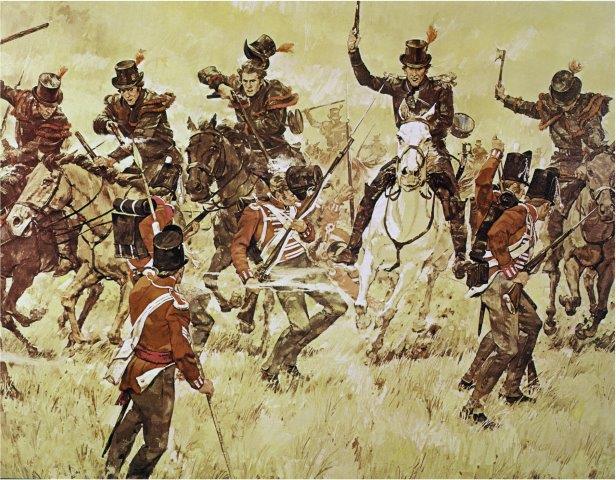 Remember the River Raisin by Ken Riley for the state of Kentucky, 1813.
Remember the River Raisin by Ken Riley for the state of Kentucky, 1813.
Following Commodore Perry's success at Lake Erie, a U.S. force, commanded by Gen. William Henry Harrison, engaged British troops 75 miles east of Detroit.
His command included a regiment of Kentucky Mounted Riflemen led by Col. Richard M. Johnson, made up of picked militia volunteers armed with long Kentucky rifles and tomahawks.
The Kentucky troops scattered the enemy army -- British regulars, and Indians under the famed Tecumseh. The Battle of the Thames was revenge for an earlier massacre of Kentucky militia on the River Raisin. Coupled with Perry's triumph, it ended a series of defeats and helped restore U.S. dominance in the northwest region
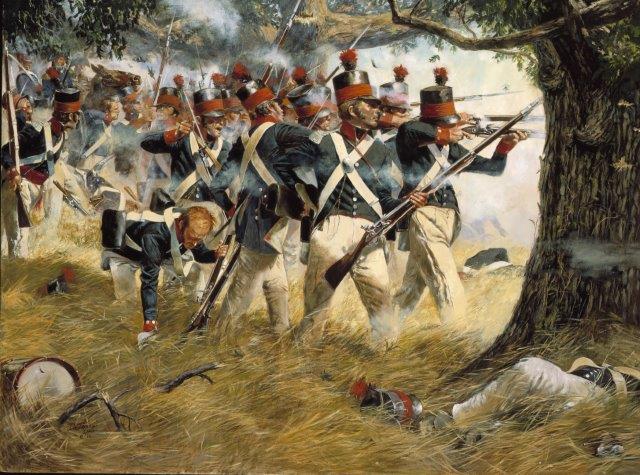 Battle of North Point by Don Troiani for the state of Maryland, 1814.
Battle of North Point by Don Troiani for the state of Maryland, 1814.
On the morning of September 12, 1814, a British force of 9,000 men landed at North Point, Maryland, with the intention of marching inland and capturing Baltimore. Brig. Gen. John Stricker, commander of the 3d Brigade of the Maryland militia, was ordered to delay the British advance so that the defense entrenchments around the city could be completed.
The 5th regiment was assigned the task of holding the American right flank. Despite two hours of artillery and rocket fire, the 5th Maryland stood their ground. After inflicting some 300 casualties, the 5th was order to fall back to a new position in front of the Baltimore trenches. The British army, exhausted by the fighting and surprised by the stubborn defense of the Maryland militia, withdrew, while the British navy failed to silence the guns of Fort McHenry in Baltimore Harbor.
Thwarted on land and sea the British force sailed away. The successful defense of Baltimore, after the humiliating capture of Washington, shored up the confidence of the American people and directly contributed to the ending of the War of 1812. Moreover, an American militia regiment had withstood two hours of difficult fighting against British veterans of the Napoleonic wars. Today's 1st and 2d Battalions, 175th Infantry, Maryland Army National Guard, carry on the gallant traditions of the 5th Maryland.
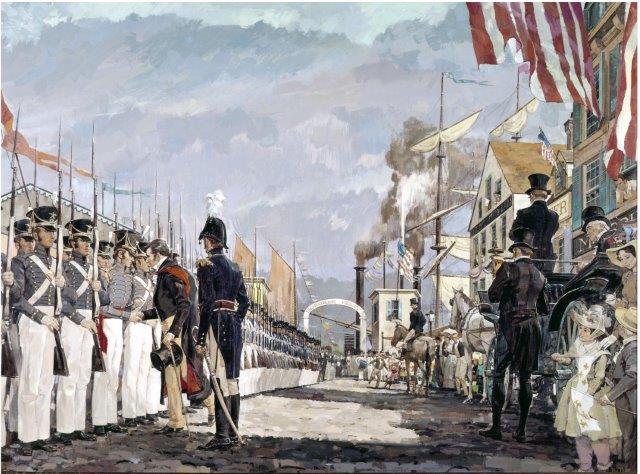 Lafayette and the National Guard by Ken Riley for the state of New York, 1825.
Lafayette and the National Guard by Ken Riley for the state of New York, 1825.
The visit of the Marquis de Lafayette to the U.S., in 1824-25, was in every sense a triumphal procession. The 2d Battalion, 11th New York Artillery, was one of many militia commands turned out in welcome.
This unit decided to adopt the title "National Guard," in honor of Lafayette's celebrated Garde Nationale de Paris. The Battalion, later the 7th Regiment, was prominent in the line of march on the occasion of Lafayette's final passage through New York en route home to France.
Taking note of the troops named for his old command, Lafayette alighted from his carriage, walked down the line, clasping each officer by the hand as he passed. "National Guard" was destined to become the name of the U.S. militia.
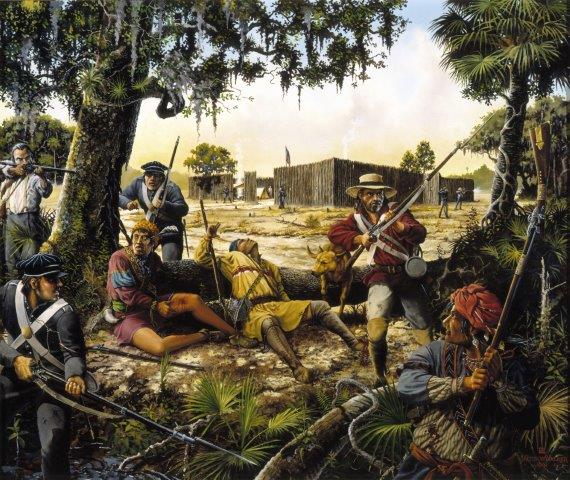 The Macon Volunteers by Jackson Walker for the state of Georgia, 1836.
The Macon Volunteers by Jackson Walker for the state of Georgia, 1836.
In 1821, when Florida became part of the U.S., it was home to about 5,000 Seminole Indians. In 1823 the Seminoles were persuaded to move to a reservation, but by 1830 the U.S. government had made plans to remove the entire tribe to Arkansas. The "non-removers," led by a chief the Whites called Osceola, vowed to resist. In November 1835 the senior Army commander in Florida accepted 500 Florida mounted militia into Federal service, and Regular troops they immediately began patrolling isolated plantations.
This mission took on a new urgency after December 28, when the Seminoles under Osceola ambushed and massacred a column of U.S. troops. Only three soldiers survived out of 108. When officials called for more troops, South Carolina, Louisiana, Alabama, and Georgia responded immediately. Part of Georgia's quota of 3,500 for Federal service were the Macon Volunteers. In February of 1836, as part of the 1st Battalion, Georgia Volunteers, the Macon company departed for Picolata, west of St. Augustine, where they were sworn into active Federal service for 90 days. Major General Winfield Scott, just arrived to assume command, sent the 321 Georgians, along with 720 regulars and almost 1,000 Louisiana militia, to the edge of the Withlacoochee Swamp.
After several skirmishes and a river crossing under fire, the number of wounded and sick began to multiply. General Scott ordered them left behind under the care of the Georgia Battalion assisted by a few artillerymen with a six-pound gun. Under constant attack from the Seminoles (one party of 50 Georgians held off more than 200 Indians), the men began building a log fort named after their commander, Major Mark Anthony Cooper. As they alternated between work parties, patrolling, and guarding the hastily-constructed log stockade, rations and ammunition began to run low. On April 17, the Georgia Battalion was relieved by General Scott's men. They marched back to Picolata, were mustered out of Federal service, and by mid-May had sailed back to Georgia. The Seminole War continued for another six years. The Macon Volunteers continue today in the Georgia Army National Guard as Headquarters and Headquarters Company, 48th Infantry Brigade.
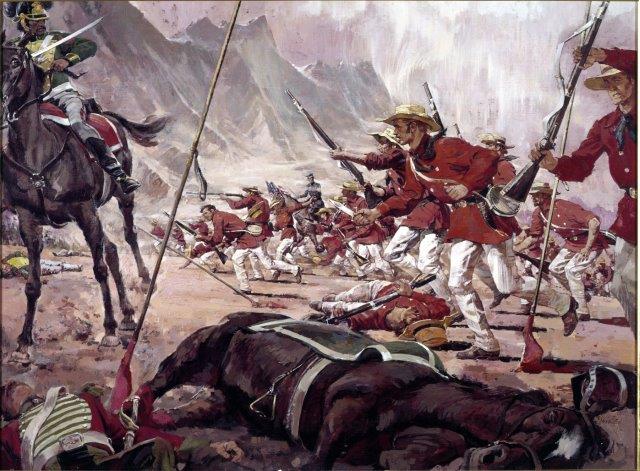 The Mississippi Rifles by Ken Riley for the state of Mississippi, 1847.
The Mississippi Rifles by Ken Riley for the state of Mississippi, 1847.
Fighting in the open on a dusty mountainside in a foreign land a thousand miles from home, facing an enemy many times its own strength, the Mississippi Rifles displayed a rock-like defense against a Mexican attack in response to the command, "Stand Fast, Mississippians!"
Earlier, the battle had reached a critical stage when the Rifles (in the action depicted) were ordered to attack Mexican cavalry and infantry advancing on the Americans. The "hard-fighting Mississippi gentlemen" moved up, fired, then drew Bowie knives and closed in.
The Rifles--the 155th Infantry of the modern Mississippi Army National Guard--thus wrote another chapter in the proud National Guard tradition.
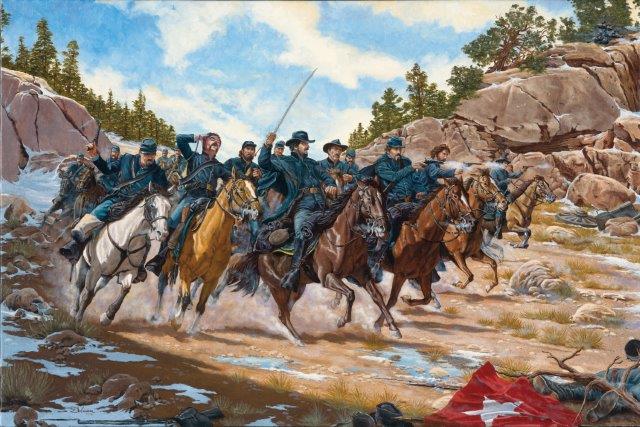 Battle of Glorieta Pass: Action at Apache Canyon by Domenick d'Andrea for the state of Colorado, 1862.
Battle of Glorieta Pass: Action at Apache Canyon by Domenick d'Andrea for the state of Colorado, 1862.
At the start of the Civil War, Confederate Brig. Gen. Henry H. Sibley proposed a plan to seize mining centers in Colorado and California. Sibley recruited three Texas volunteer regiments of cavalry and artillery numbering 3,000 men. They would seize the New Mexico and Colorado Territories. Sibley’s small army conducted a successful campaign up New Mexico’s Rio Grande Valley. Meanwhile, reinforcements from neighboring Colorado Territory moved south to prevent the Texans from seizing Fort Union, the primary garrison along the Santa Fe Trail.
First Colorado Volunteer Infantry, New Mexico volunteers, and other soldiers encountered Texas forces near Glorieta Pass on March 26, 1862, east of Santa Fe. This high point on the southern end of the Sangre de Cristo Mountains crossed the route to Fort Union. A Company of Colorado mounted infantry charged the Confederates west of the Glorieta summit in snowy Apache Canyon. This advance halted at dusk without a clear victory.
The armies engaged again on March 28. Day’s end seemed to bring about victory for the Southerners. Confederate fortunes changed dramatically when a force of Colorado and New Mexico troops destroyed the Confederate supply train near Johnson’s Ranch. Unable to continue the advance northwards, Sibley and his troops retreated back toward Santa Fe and ultimately back to Texas. The Battle of Glorieta Pass, sometimes called the "Gettysburg of the West," ended Confederate hopes of establishing access to mineral resources in Colorado. Colorado and New Mexico territorial troops had effectively preserved the Union in the west. The proud heritage of these citizen-soldiers lives on in today's Colorado and New Mexico Army National Guards
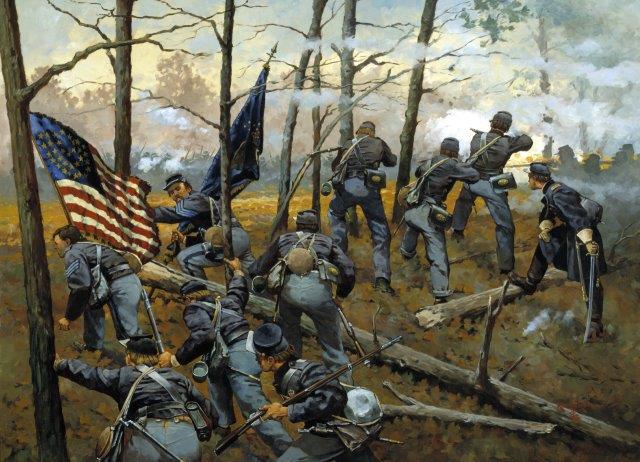 Plenty of Fighting Today - The 9th Illinois at Shiloh by Keith Rocco for the state of Illinois, 1862.
Plenty of Fighting Today - The 9th Illinois at Shiloh by Keith Rocco for the state of Illinois, 1862.
Originally organized in 1809, in 1861 the 9th Illinois Infantry responded immediately to the call of President Lincoln, a company commander in the regiment during the Black Hawk War. Many of those who mustered in were German immigrants.
The 9th was at Shiloh, Tennessee on April 6, 1862 when the Confederate Army of the Mississippi struck at dawn. Some Union regiments fled in panic as Major General U.S. Grant ordered his division commanders to hold at all costs. Sent to reinforce the Union left, the 9th was told "There is going to be plenty of fighting today; there must be no cowards." South of the Peach Orchard, the regiment was ordered to a tree-choked ravine, and found themselves in a race with Confederates for the same natural barrier.
The 9th got there first. Confederate commander Albert Sidney Johnston remarked on the Illinois regiment's stubborn stand" as the 9th Arkansas and 29th Tennessee joined the fight. Finally, renewed attacks collapsed the 12th and 15th Illinois on the 9th's flanks and with their dead and wounded thick on the ground, the regiment had to withdraw. The 9th suffered 103 killed and 258 wounded on Shiloh's first day, one of the highest totals of the entire Civil War. Their 90-minute stand helped save Grant's left, and prepared the way for the great Union Counterattack the next day. The proud heritage of the 9th Illinois is carried on today by the 130th Infantry Regiment, Illinois Army National Guard.
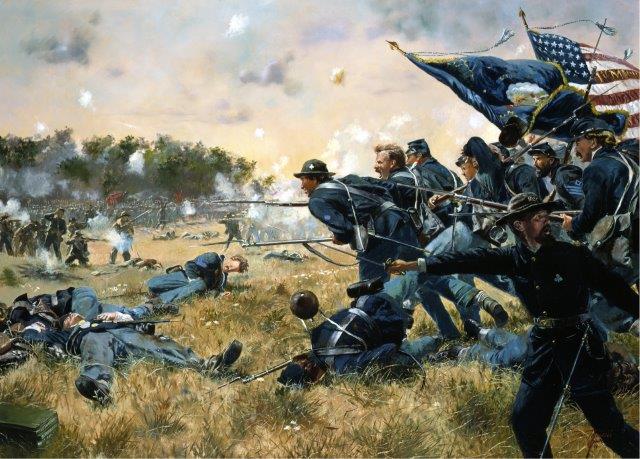 The First Minnesota by Don Troiani for the state of Minnesota, 1863.
The First Minnesota by Don Troiani for the state of Minnesota, 1863.
Among the many militia regiments that responded to President Lincoln's call for troops in April 1861 was the First Minnesota Infantry. As the First Union regiment to volunteer for three years of service, the First Minnesota fought at the battles of Bull Run, Antietam and Fredericksburg.
It was, however, during the Battle of Gettysburg that the First Minnesota played a significant role in American military history. On the morning of July 2, 1863, the First Minnesota, along with the other units of the II Corps, took its position in the center of the Union line on Cemetery Ridge. Late in the day, the Union III Corps, under heavy attack by the Confederate I Corps, collapsed creating a dangerous gap in the Union line. The advancing Confederate brigades were in position to breakthrough and then envelope the Union forces. At that critical moment, the First Minnesota was ordered to attack.
Advancing at double time, the Minnesotans charged into the leading Confederate brigade with unbounded fury. Fighting against overwhelming odds, the heroic Minnesotans gained the time necessary for the Union line to reform. But the cost was great. Of the 262 members of the regiment present for duty that morning, only 47 answered the roll that evening. The regiment incurred the highest casualty rate of any unit in the Civil War. The gallant heritage of the First Minnesota is carried on by the 1st and 2nd Battalions, 135th Infantry, Minnesota Army National Guard
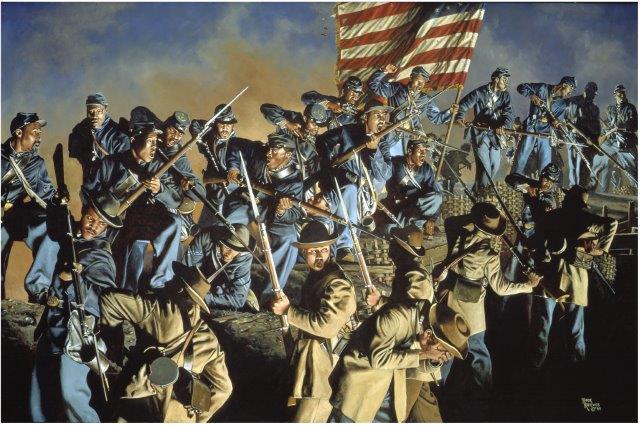 The Old Flag Never Touched the Ground by Rick Reeves for the state of Massachusetts, 1863.
The Old Flag Never Touched the Ground by Rick Reeves for the state of Massachusetts, 1863.
The 54th Massachusetts Volunteer Infantry Regiment was recruited in the spring of 1863 by Governor John Andrew, who had secured the reluctant permission of the War Department to create a regiment of African-American soldiers. Like all Massachusetts Civil War soldiers, the 54th's men were enlisted in the Massachusetts Volunteer Militia. These Guardsmen would serve as a test case for many skeptical whites who believed that blacks could not be good soldiers.
The battle that proved they could was fought on Morris Island, at the mouth of Charleston Harbor. Following three days of skirmishes and forced marches with little rest, and 24 hours with no food, the regimental commander, Colonel Robert Gould Shaw, requested the perilous honor of leading the attack of Fort Wagner, a sand and palmetto log bastion. As night fell, 600 men of the 54th advanced with bayonets fixed. Despite withering cannon and rifle fire, the men sustained their charge until they reached the top of the rampart. There, Colonel Shaw was mortally wounded. There, also, Sergeant William Carney, who had earlier taken up the National Colors when the color sergeant had been shot, planted the flag and fought off numerous attempts by the Confederates to capture it. Without support, and faced with superior numbers and firepower, the 54th was forced to pull back.
Despite two severe wounds, Sergeant Carney carried the colors to the rear. When praised for his bravery, he modestly replied, "I only did my duty; the old flag never touched the ground." Carney was awarded the Medal of Honor for his actions, the first African-American to receive the award. The 54th Massachusetts suffered 270 casualties in the failed assault, but the greater message was not lost: some 180,000 African-American soldiers followed in the footsteps of these gallant Guardsmen, and proved that African-American soldiers could, indeed, fight heroically if given the opportunity.
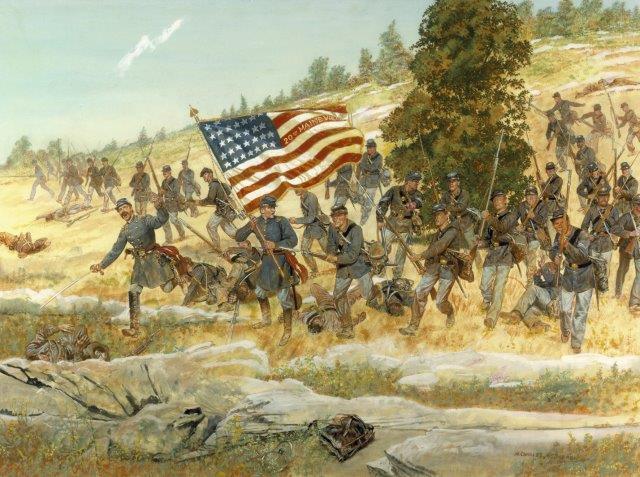 The Twentieth Maine by H. Charles McBarron for the state of Maine, 1863.
The Twentieth Maine by H. Charles McBarron for the state of Maine, 1863.
The Battle of Gettysburg, the largest battle ever fought in the Western hemisphere, is often called the turning point of the Civil War. The battle was a narrow victory for the Union and could have been a Confederate victory if it were not for a series of critical events. One such episode involved the 20th Maine Infantry. Organized in the Maine Volunteer Militia in August 1862, the 20th Maine mustered into Federal service several weeks later. Assigned to the Army of the Potomac, the regiment fought in the Antietam, Fredericksburg, and Chancellorsville campaigns.
At Gettysburg, the 20th was commanded by Colonel Joshua L. Chamberlain, a former professor at Maine's Bowdoin College. After marching all day and night to reach Gettysburg, the regiment was ordered late in the afternoon of July 2 to occupy critical terrain between two hills, Big and Little Round Top. Chamberlain was ordered to hold this position on the extreme left flank of the Union line at all costs; if outflanked by the Confederates, the entire Union position would be in jeopardy. It was not long before the 15th and 47th Alabama Regiments attacked. The 20th Maine held off six attacks by the determined Alabama men, but Colonel Chamberlain knew that his regiment, low on ammunition, could not withstand a seventh. He therefore ordered a counterattack with fixed bayonets, and the 20th charged down the slopes of Little Round Top into the startled Confederates and broke their attack. The 20th Maine took 400 prisoners and stopped the Confederates threat to the Union flank.
The crucial role these Maine militiamen played in the Union victory at Gettysburg exemplifies the military qualities of leadership, initiative, unit cohesion and gallantry. Joshua Chamberlain was awarded the Medal of Honor for his actions of July 2, 1863. At Appomattox Courthouse almost two years later, it was Brevet Major General Chamberlain, chosen to accept the Confederate surrender, who ordered Union troops to present arms to their former enemy as a mark of respect. After the war Chamberlain was elected Governor of Maine, and completed his military career as a major general in the Maine National Guard. The heritage of the 20th Maine is carried on today by the 133d Engineer Battalion, Maine Army National Guard.
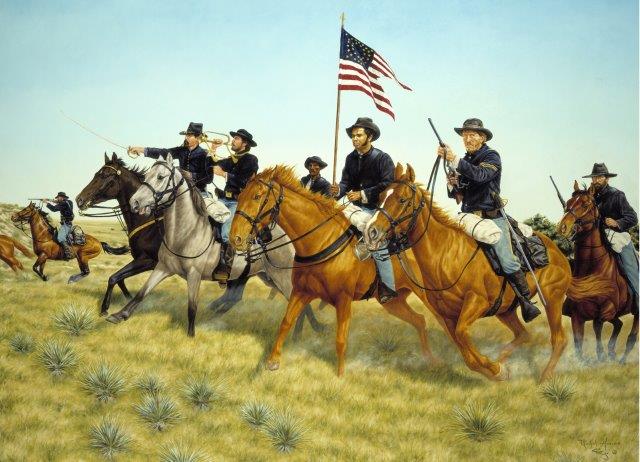 The Battle of Prairie Dog Creek by Ralph Heinz for the state of Kansas, 1867.
The Battle of Prairie Dog Creek by Ralph Heinz for the state of Kansas, 1867.
After the Civil War, settlers rushed to the rich and relatively empty lands of the Great Plains. By mid-1867 the Plains Indian tribes recognizing the threat to their traditional way of life, were regularly attacking settlers, railroad workers and travelers. When the angry and frightened citizens of Kansas demanded military help, the War Department authorized placing volunteer militia units on active duty during the emergency.
On July 15, 1867, four companies of the 18th Kansas Volunteer Cavalry were mustered into Federal service. Under command of Captain Horace L. Moore, the 18th set out immediately for a month of vigorous campaigning. Returning to camp at Ft. Hays, then in the midst of a cholera epidemic, the Kansans then joined forces with the 10th U.S. Cavalry, the famous black "Buffalo Soldiers." A combined force of 135 men, commanded by Captain George A. Armes of the 10th, rode down the Saline River; Captain Moore, with 125 Kansans, scouted upstream.
The two groups had lost contact with each other when Captain Armes' group was struck by 300 to 400 Kiowas and Cheyennes under the great war chiefs Satanta and Roman Nose. As Armes' group of men held their ground through fierce fighting, the men of the 18th Kansas, hearing the noise of battle, managed to fight their way through to Armes. To break the stalemate, Captain Armes formed a party for a charge on the Indians. Led by Armes, the force of about 20 black regulars and regulars and Kansas volunteers moved first toward Prairie Dog Creek, and then, turning charged up the hill toward the main body of warriors. The Indians broke and scattered, ending the day's fighting. The cavalry had lost 3 men dead and 36 wounded; the Indians, 50 dead and 150 wounded. The Battle of Prairie Dog ended the U.S. offensive operations on the Kansas frontier for the year, and in the fall treaties were signed with the tribes of the Southern Plains. The proud tradition of the 18th Kansas Volunteer Cavalry is carried on today by the men and women of the Kansas Army and Air National Guard
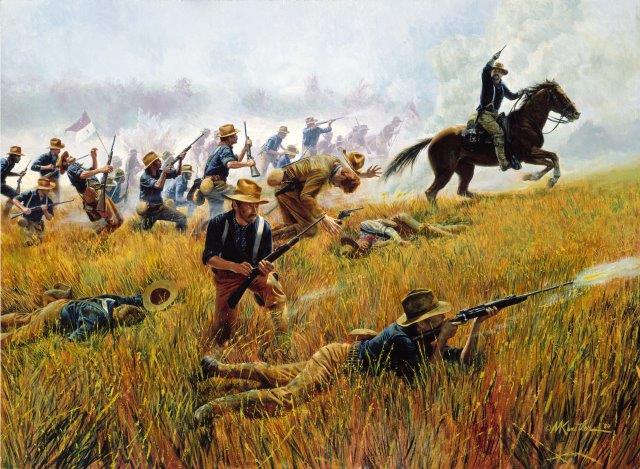 The Rough Riders by Mort Kunstler for the state of New Mexico, 1898.
The Rough Riders by Mort Kunstler for the state of New Mexico, 1898.
With the declaration of war with Spain in April 1898, 164,932 National Guardsmen entered Federal service. The 1st New Mexico Cavalry entered Federal service as the 2nd Squadron, 1st U.S. Volunteer Cavalry, better known as the "Rough Riders." Theodore Roosevelt conceived the idea of raising a cavalry regiment recruited from businessmen, cowboys and outdoorsmen.
Roosevelt, a former New York National Guardsman, helped to organize the regiment and was appointed its lieutenant colonel. After training in Texas and Florida, the Rough Riders landed in Cuba, without their horses, on June 22, 1898. It was during the Battle of San Juan Hill, on July 1, that the Rough Riders, under the command of Lt. Col. Roosevelt, made their mark in American military history. Ordered to seize Kettle Hill in support of the main attack, the Rough Riders fought their way to the top despite heavy enemy fire. New Mexico's E and G Troops were among the first to reach the top of Kettle Hill.
After taking the hill, the Rough Riders continued their attack, seizing the heights overlooking the city of Santiago. The American victory led to the Spanish surrender two weeks later. The gallant heritage of the 2nd Squadron of the Rough Riders is perpetuated by the 200th Air Defense Artillery, New Mexico Army National Guard.
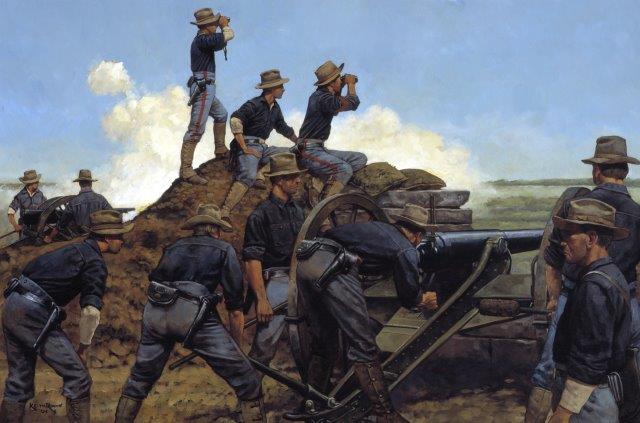 The Utah Light Artillery by Keith Rocco for the state of Utah, 1898.
The Utah Light Artillery by Keith Rocco for the state of Utah, 1898.
On April 6, 1898, Congress declared war on Spain and President William McKinley organized United States forces for the "Splendid Little War." Of the tens of thousands of regular, volunteer and National Guard (Militia) troops who served, 343 Utah Guardsmen saw service in the Philippine Islands.
On May 1st, after the Navy's stunning victory at Manila Bay, McKinley authorized an invasion force to capture the Philippine archipelago from Spain. Organized into two batteries, the Utah "Light" Artillery mustered into federal service on May 9, 1898 at Fort Douglas, Utah. Shortly thereafter, at Camp Merritt near San Francisco, the Utah Artillery became part of Brig. Gen. Francis V. Greene's brigade of the U.S. VIII Corps under the command of Maj. Gen. Wesley Merritt. Leaving San Francisco, Greene's brigade first raised the U.S. flag in Guam and then arrived on the island of Luzon on July 17, 1898.
In the Philippines, 15,000 Americans not only faced 13,000 Spanish soldiers but a second army of some 12,000 Philippine rebels under Emilo Aguinaldo. The rebels had been fighting for national independence from Spain and hoping for American assistance. When Merritt ordered to keep the rebels out of the fight against Spain, the rebels became a second possible enemy. On August 13th, the Utah Artillery supported Greene's brigade as it attacked towards the "old" city of Manila. The battle was predetermined to be a "limited" one in order to preserve Spanish honor and minimize casualties.
The rebels, however, made this impossible. As American forces moved quickly against the Spanish defenses, a race to the old city center developed between the Americans and Aguinaldo's rebels. The Utah batteries fired and re-deployed several times providing close and accurate support for the infantry attacks. The Utah Light Artillery continued in federal service for another year and fought in the Philippine Insurrection until returning to Utah in August 1899. Today's 145th Field Artillery, Utah Army National Guard, carries on the history and traditions of the Utah Light Artillery.
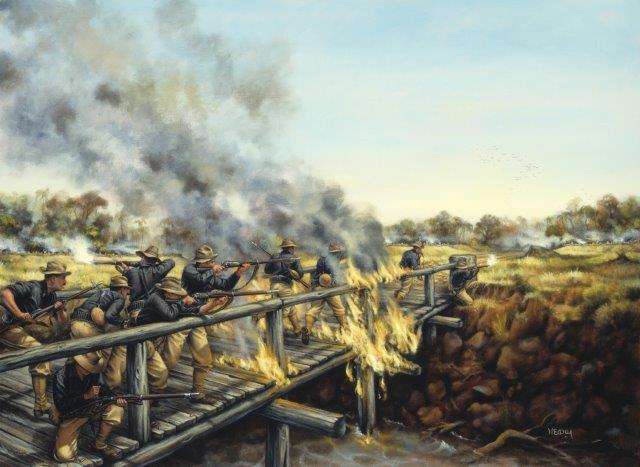 Soldiers in the Sun by Donna Neary for the state of North Dakota, 1899.
Soldiers in the Sun by Donna Neary for the state of North Dakota, 1899.
One month after the Spanish-American War began an expeditionary force sailed from San Francisco to the Philippine Islands. Because most of the Regular Army was in Cuba and Puerto Rico, three-quarters of the first 10,000 U.S. Army troops to arrive in the Philippines were National Guardsmen, most of them from the West and Midwest.
The Spanish surrendered quickly, but the Guardsmen soon had another enemy: Filipinos fighting for their independence. In the spring of 1899 the 1st north Dakota Infantry was part of an expedition to clean our Insurgent strongholds north of Manila. When a civilian named Henry Young organized an elite scouting and reconnaissance force, 16 North Dakotans were selected for this detail, which also included four men from the 2d Oregon. Of Young and his 25 Scouts one historian wrote "Always in front of the main column, the scouts bore the brunt of the advance, reconnoitering and maintaining contact with the enemy."
On May 13, a reconnaissance party ran into a band of about 300 Insurgents. Without hesitation 11 Scouts charged the Filipinos and routed them; Young himself was mortally wounded. Three days later, while reconnoitering for water, the Scouts discovered that the Insurgents had set an important bridge on fire. Knowing the river below as unfordable, the 22 Scouts rushed the bridge and put out the flames, despite an enfilading fire from some 600 Insurgents. Supported by the 2d Oregon, the Scouts then drove the Insurgents from their trenches. Fourteen Guardsmen were awarded the Medal of Honor during the first year of the Philippine Insurrection. Of that 14, ten were members of Young's Scouts, decorated for their actions on 13 and 16 May 1899. Seven men were from the 1st North Dakota and three from the 2d Oregon. Today, the 1st North Dakota is perpetuated by the 164th Engineer Group and the 141st Engineer Battalion North Dakota Army National Guard, and the 2d Oregon by the 162d Infantry Regiment Oregon Army National Guard.
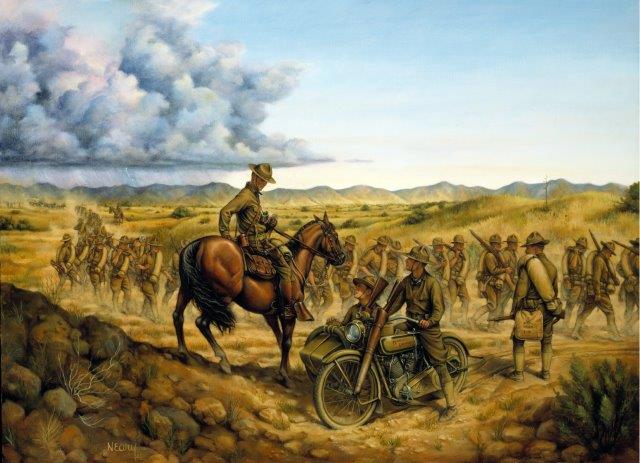 On the Border by Donna Neary for the state of Connecticut, 1916.
On the Border by Donna Neary for the state of Connecticut, 1916.
On March 9, 1916, Mexican rebels led by Pancho Villa attacked the United States Army garrison at Columbus, New Mexico. All available troops were rushed to the United States - Mexican border, but there were not enough regulars to patrol such a vast area. On May 9, the National Guard of Arizona, New Mexico and Texas was called into Federal service. On June 18, the entire National Guard, except for coast artillery units, were called.
Within days the first of 158,664 National Guardsmen were on their way to camps in Arizona, New Mexico and Texas. National Guard units began patrolling the border immediately and columns of Guardsmen soon dotted the desolate landscape from Arizona to Texas. Among the many units on the border was the 2nd Connecticut Infantry. On June 20, 1916, the regiment assembled and began preparations for the long rail journey to the border. Within a week they were on a troop train headed for Nogales, Arizona. Although their patrols along the border were important, the training that the Guardsmen received was invaluable. Guardsmen were physically toughened and officers and NCOs gained experience in handling troops in the field.
The 2nd Connecticut mustered out of Federal service in November 1916, only to be mobilized again in February 1917. The training that the regiment received in Arizona would be important after the United States entered World War I two months later. Re-designated as the 102d Infantry and assigned to the famous 26th "Yankee" Division, the regiment fought in six World War I campaigns. The 102d Infantry, Connecticut Army National Guard continues its proud record of over 300 years of service to state and nation.
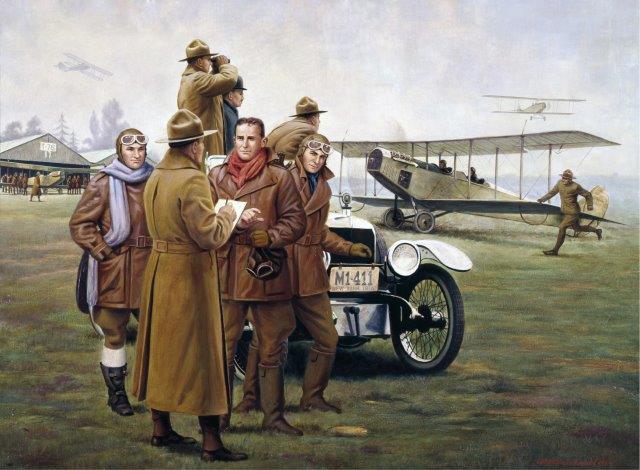 Trail-Blazers in the Sky by Woodi Ishmael for the state of New York, 1916.
Trail-Blazers in the Sky by Woodi Ishmael for the state of New York, 1916.
One by one, the ten JN-4 "Jennies" dropped out of cloud-laden skies at the end of a trail-blazing cross-country flight. The date was November 19, 1916 and these pioneer aviators, members of New York's 1st Aero Company, had just completed an historic roundtrip from Mineola, N.Y., to Princeton, New Jersey. The flight, hailed by the press as "the largest number ever seen on one flight in this country," was the first mass cross-country flight in U.S. military aviation. The first leg of the historic flight was launched on Saturday, November 18, with a rendezvous of twelve airplanes over Governor's Island, New York.
The flight leader, an airman destined to be one of the great names in World War I aviation-Captain (later Colonel) Raynal Cawthorne Bolling, formed the aero unit in 1915. Navigating by familiar landmarks on the roads and fields, the adventuresome National Guard pilots (two aircraft piloted by civilian trainees flew only the first leg), made the return trip on Sunday, November 19, a cold and overcast day. Truly a pioneer in militia aviation, the 1st Aero Company was the first ever to be called into Federal service, in June 1916. A year later most of its members were flying combat missions in France. But the first formation cross-country flight, a pioneer accomplishment soon to be eclipsed by the great strides in aviation, nevertheless set the stage for the accomplishments of the Air National Guard in the years to come.
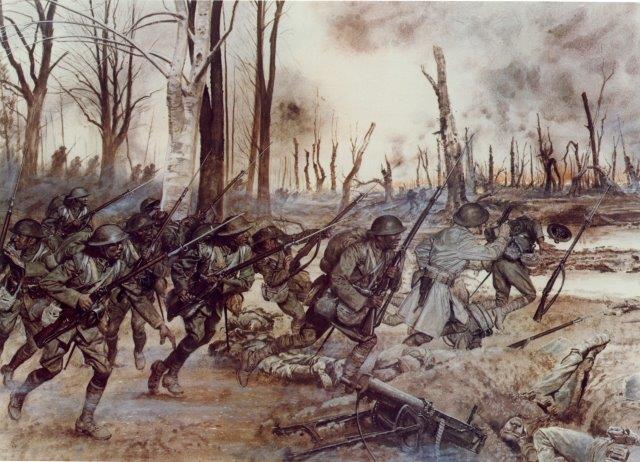 "Hell Fighters" from Harlem by H. Charles McBarron for the state of New York, 1918.
"Hell Fighters" from Harlem by H. Charles McBarron for the state of New York, 1918.
From Harlem streets and other New York City neighborhoods they came, members of the only U.S. unit to get "over there" with their old State name - the 15th New York. These black National Guardsmen soon found themselves with a new name, the 369th Infantry Regiment. Many months after their arrival in the war zone the 369th Infantry, as part of the French Army's 161st Division, marched toward a date with destiny in the Meuse-Argonne offensive. On a fateful day, September 29, a regimental historian would later remember, "the day dawned clear and cool.
There was expectancy in the air." A fierce artillery barrage preceded the attack by the 369th, nickname "Hell Fighters" by the enemy. After a brutal struggle during which heavy casualties were sustained Sechault was taken and the 369th soldiers dug in to consolidate their advance position.
The action depicted earned the Croix de Guerre for the entire regiment. But the Meuse-Argonne claimed nearly one-third of these black fighters men as battle casualties. This distinguished National Guard regiments left its proud mark on the AEF as "the regiment that never lost a man captured, a trench or a foot of ground..." Today's 369th Transportation Battalion, New York Army National Guard, carries on the traditions of the gallant "Hell Fighters" of yesterday.
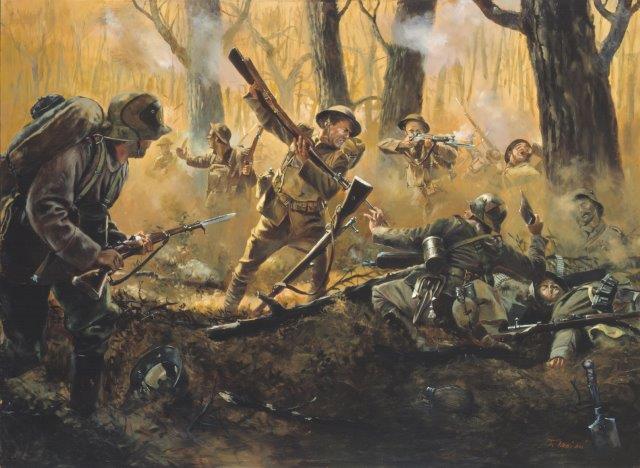 Men of Iron by Don Troiani for the state of Pennsylvania, 1918.
Men of Iron by Don Troiani for the state of Pennsylvania, 1918.
Among the 17 National Guard divisions assigned to the American Expeditionary Force during World War I was the 28th Division, Pennsylvania National Guard. The 28th received its baptism of fire on July 15, 1918, during the German Army's Champagne-Marne Offensive. Four companies from the 28th were attached to a French division on the front line, while the rest of the division took up second-line defense positions. Two of the companies, L and M, were from the 109th Infantry Regiment made of the old 1st and 13th Pennsylvania Regiments. In the early hours of July 15, the German 36th Division crossed the Marne River and attacked the Allied front. When the adjacent French units fell back, L and M Companies were surrounded.
Wave after wave of Germans attacked the Pennsylvanians. Despite the overwhelming odds, the two companies stubbornly held their position and inflicted heavy casualties. At 0800 the remnants of L and M Companies withdrew and fought their way back to the front line of the 109th, five kilometers away. Of the 500 assigned officers and men only 150 remained. The brunt of the German offensive now fell on the 109 Infantry and the other units of the 28th Division. For three days, the 109th held its positions while under heavy attack.
Fighting in ravines, woods and trenches, the doughboys fought like veterans. A German after-action report described the battle as "the most severe defeat of the war." For its staunch defense the 109th was nicknamed "Men of Iron" and the 28th was later dubbed the "Iron Division." Today's 103d Engineer Battalion (The Dandy First) and the 109 Infantry (Thirteenth Pennsylvania) continue the proud heritage of the "Men of Iron."
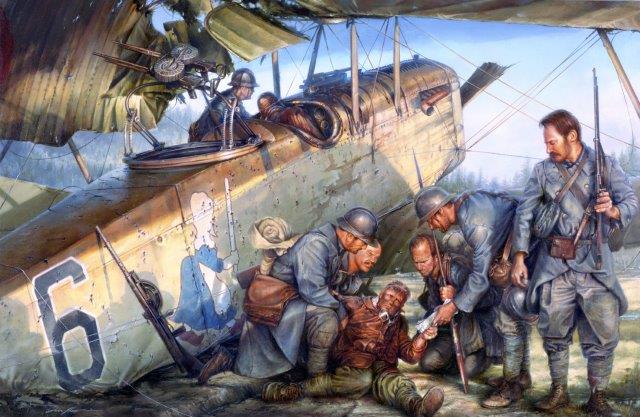 The Highest Possible Courage by John D. Shaw for the state of Kansas, 1918.
The Highest Possible Courage by John D. Shaw for the state of Kansas, 1918.
Only four Army Air Service aviators received the Medal of Honor during World War I, half of them for one of the most famous episodes of that terrible conflict -- the rescue of the famous "Lost Battalion." Second Lieutenant Erwin R. Bleckley, a field artilleryman from the Kansas National Guard, was an aerial observer attached to the Air Service's 50th Aero Squadron. Bleckley and other Guardsmen had volunteered as individuals for aviation duty during the war. He and other members of the 50th Aero Squadron had been assigned to locate and resupply the 1st Battalion, 308th Infantry, 77th Division. That "Lost Battalion" had been completely cut off and pinned down in a deep ravine by German forces on October 3, 1918, while advancing in the Argonne Forest as part of General John J. Pershing's Meuse-Argonne offensive with 600,000 troops of the American Expeditionary Force.
Having failed to locate the "doughboys" on their first mission of the day, Bleckley and his pilot, First Lieutenant Harold E. Goettler, had volunteered for a second. Flying barely above the treetops and steep ravines, they drew intense enemy fire while making several passes over the area where they expected to find the American troops. German machine gunners fired down at the flyers from the ridges above their fragile aircraft, as well as from below it. Badly wounded and with their De Havilland aircraft severely damaged, with at least 40 bullet holes in it, they made a forced landing near a French outpost. Goettler was dead when the French troops reached him. Bleckley died before the French could evacuate him to a medical aid station. However, his notes from the mission narrowed the search area where the trapped soldiers might be found. Each aviator received the Medal of Honor, posthumously, for his courage and sacrifice. Their mission underscored the critical importance of observation aviation to allied ground forces during World War I. Erwin Bleckley was the first of three National Guard aviators to receive the Medal of Honor during the twentieth century.
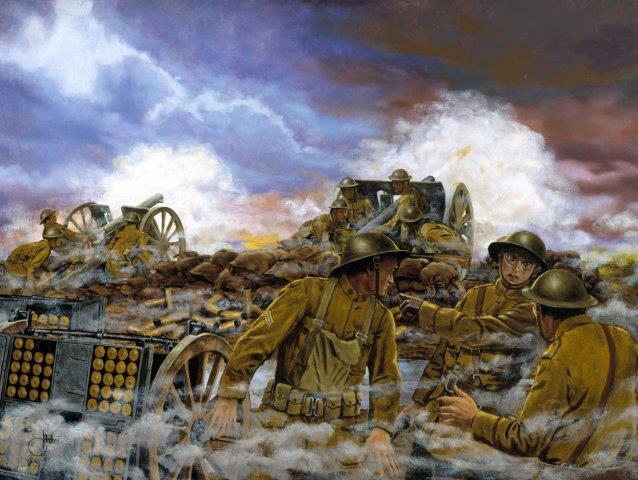 Truman's Battery by Domenick D'Andrea for the state of Missouri, 1918.
Truman's Battery by Domenick D'Andrea for the state of Missouri, 1918.
At 0420 hours, September 26, 1918, the ground of France shook as 2,700 guns began to fire the artillery preparation for what was to be final offensive of the first great war of the 20th century. America had entered the First World War in 1917, almost three years after it began. Allied and enemy troops were exhausted by the years of bloodletting and American troops were seen by the British and French as the way to end the War.
A future president of the United States became embroiled in the conflict. Harry S. Truman had joined the Missouri National Guard in 1905 as an enlisted man and was discharged as a corporal after two enlistments. He rejoined the Guard after the declaration of war in 1917, was commissioned a second lieutenant in the 129th Field Artillery Regiment, a unit in the 35th Division of the Kansas and Missouri National Guards.
The 35th Division was sent to France May, 1918. After advanced training and acclimatization of the troops to trench warfare, the division, with its artillery, was assigned to take part in the Argonne offensive, the combat debut of the U.S. First Army. As the time ticked off to begin the massive preparation that would herald the offensive, Captain Truman stood by the guns of Battery D, 129th Field Artillery. Truman had addressed his men earlier that he would, "...rather be right here than be President of the United States." When the order to commence firing was given, the guns spewed round after round of 75 millimeter shells at the German positions.
The fire was so rapid that wet blankets had to be wrapped around the gun barrels for ten minutes each hour to cool them off. After the barrage was completed, Captain Truman said that "...it was quiet as a church," although he could hear the rattle of machine guns firing in the distance. The 35th Division gained over six kilometers of ground on the 26th of September. Truman and his men would continue to provide support to the 35th Division until the war was over. The courage, dedication and self-sacrifice of Battery D is still present today in the members of the 129th Field Artillery (Truman's own), Missouri National Guard.
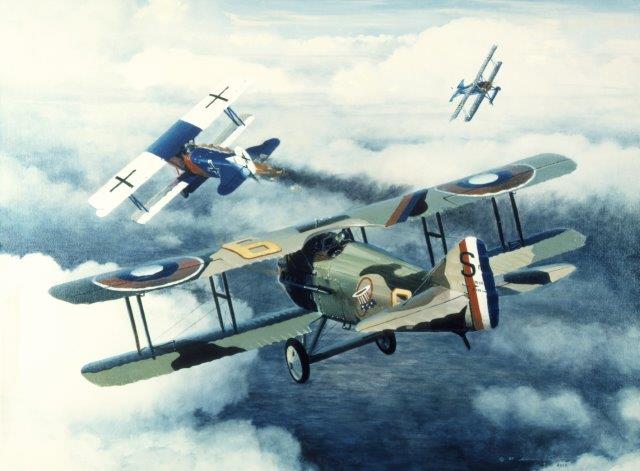 Two Down to Glory by William S. Phillips for the state of Tennessee, 1918.
Two Down to Glory by William S. Phillips for the state of Tennessee, 1918.
Between 1910 and 1917 a number of aviation units were organized in the National Guard. While only the 1st Aero Company, New York National Guard, was federally recognized, a numbered of other states had aircraft, and some 100 National Guardsmen took flight training. But when the U.S. entered World War I, the War Department decided not mobilize National Guard aviation units, and so National Guard aviators entered Federal service as individuals.
First Lieutenant Reed M. Chambers, a former Tennessee Guardsman, was assigned to the 94th Aero Squadron along with Eddie Rickenbacker, who would become the leading American ace of the war. The squadron arrived in France on March 4, 1918, and one month later became the second American flying unit to see action, credited with two kills on its first day in combat. The 94th participated in the Chateau-Thierry and Aisne-Marne campaigns, and then in the Meuse-Argonne offensive, the largest U.S. operation of the war.
On October 22, 1918, 1st Lieutenant Chambers, flying his Spad, shot down two Fokker D-7s to become the first national Guard ace of the war. Chambers was awarded the Distinguished Service Cross with an oak leaf cluster for extraordinary heroism in aerial combat and ended the war with five downed German plans to his credit. After the war, combat-experienced aviators such as Reed Chambers returned home and organized 18 National Guard observation squadrons, which became the nucleus of today's Air National Guard.
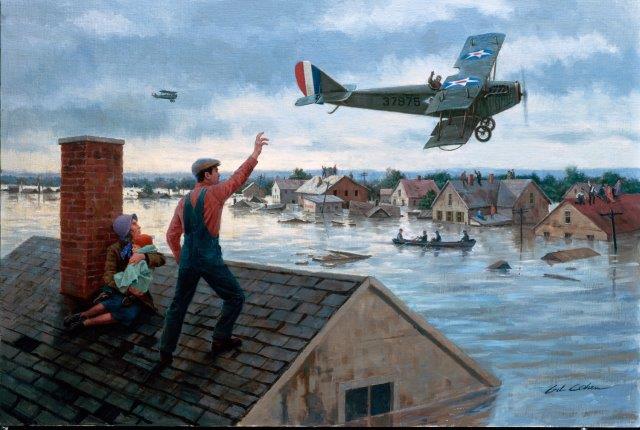 Great Flood of 1927 by Gil Cohen for the state of Arkansas, 1927.
Great Flood of 1927 by Gil Cohen for the state of Arkansas, 1927.
The great Mississippi River flood of 1927 was one of the worst natural disasters in American history. It inundated 27,000 square miles, an area about the size of New England, killing as many as 1,000 people and displacing 700,000 more. At a time when the entire budget of the federal government was barely $3 billion, the flood caused an estimated $1 billion in damage.
Although National Guard aviation units had been regularly called upon to assist civil authorities since early in that decade, the 1927 flood marked the first time that an entire Guard flying unit and its government-issued aircraft had been mobilized to help deal with a major natural disaster. Governor John E. Martineau called up the 10 officers and 50 enlisted members of the 154th Observation Squadron, Arkansas National Guard, to help locate stranded flood victims as well as to deliver food, medicines and supplies to them and relief workers.
The unit also conducted aerial patrols along the Mississippi River scouting for weakened or broken levees. Its JN-4 Jenny aircraft flew some 20,000 miles during the mobilization which lasted from 18 April through 3 May 1927. Members of the unit also worked to strengthen and repair river levees. Flood relief operations took a toll on the 154th. Two aircraft crashed and at least three aviators were injured. The unit's remaining aircraft were grounded for maintenance and repairs at one point. Because of the heavy burden of flight operations, five of the unit's aging JN-4s had to be replaced by PT-1 trainer aircraft in mid-May 1927. The flood relief work of the 154th underscores the long-standing but little understood history of Air National Guard units and their pre-World War II antecedents in supporting civil authorities.
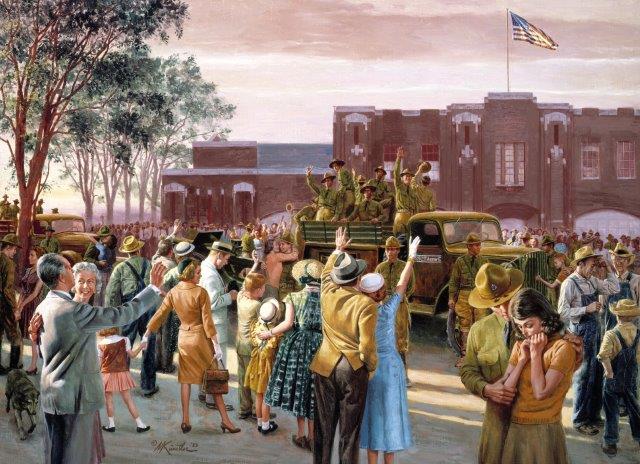 Goodbye Dear, I'll Be Back in a Year by Mort Kunstler for the state of Oklahoma, 1940.
Goodbye Dear, I'll Be Back in a Year by Mort Kunstler for the state of Oklahoma, 1940.
As the urgent need for preparedness swept over the nation in the fall of 1940, the members of Battery C, 2nd Battalion 189th Field Artillery were preparing to leave their armory for Fort Sill, Oklahoma. Several days earlier, on September 16, 1940, the president had ordered the initial callup of the National Guard for one year of Training.
The greatest peacetime mobilization in the nation's history was getting under way with National Guardsmen in hundreds of units in 27 different states answering the first call to the colors. By mid-1941, months before Pearl Harbor, the entire National Guard would be on active duty--nearly all would serve for five years or more. The mobilization of the 18 National Guard Divisions, 82 separate regiments and 29 observations squadrons doubled the size of the U.S. Army.
The National Guard played a vital role in World War II combat operations. The Oklahoma National Guardsmen of the 45th Infantry Division had little idea that morning that their departure for Fort Sill marked the shortest leg of a long journey that would take them to battlefields far from home. The 45th became one of the most famous divisions of the war taking part in eight major campaigns. The 1st Battalion, 189th Field Artillery and the other units of the 45th continue the proud "Thunderbird" heritage.
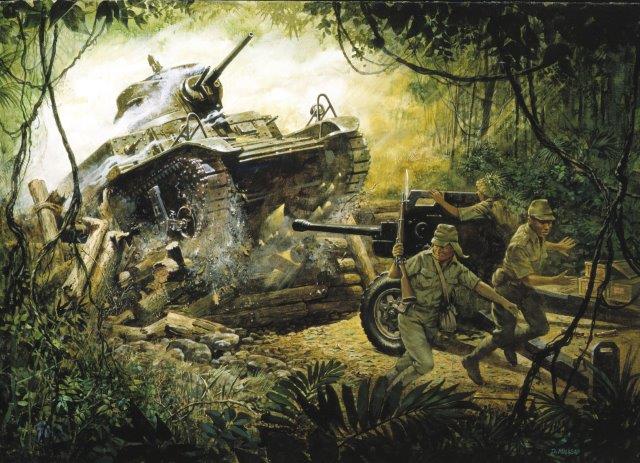 At a Roadblock on the Road to Bataan by Don Millsap for the states of California, Illinois, Kentucky, Minnesota, Ohio and Wisconsin, 1941.
At a Roadblock on the Road to Bataan by Don Millsap for the states of California, Illinois, Kentucky, Minnesota, Ohio and Wisconsin, 1941.
While the main attention of the beleaguered United States. forces in the Philippines was focused on Japanese Columns streaming inland from the Lingayen Gulf in the west, another enemy force came ashore on the east coast of Luzon at Lamon Bay. Company C 194th Tank Battalion from Salinas, California, was attached to a Filipino army regiment near the town of Lucban.
The 2d platoon was ordered to make a show of force that would take it down a narrow trail. As the tank, commanded by SSgt. Emil C. Morello, rounded a sharp curve it came face-to-face with an enemy roadblock. Without any hesitation, the tank smashed into the roadblock and the Japanese gun behind it. Before being hit, Morello's tank fired on other gun positions.
After pretending to be dead, Morello and his crew escaped the next morning only to be either killed or captured, along with the other members of the 192d and 194th Tank Battalions, at Bataan. These two battalions were National Guard units with companies from California, Illinois, Kentucky, Minnesota, Ohio and Wisconsin. For their gallantry in action, both units were awarded three Presidential Unit Citations. Today's 1st Battalion, 149th Armor, California Army National Guard carries on the gallant traditions of the 194th Tank Battalion.
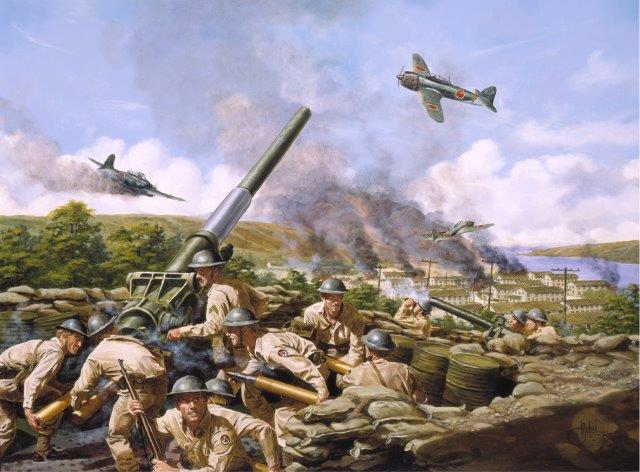 Defense of the Aleutians by Domenick D'Andrea for the state of Arkansas, 1942.
Defense of the Aleutians by Domenick D'Andrea for the state of Arkansas, 1942.
The Japanese realized that in order to win the war in the Pacific, they would have to bring the United States fleet into decisive combat. Their plan envisaged a deceptive move in a northern direction, towards the Aleutian Islands and Alaska. It would be a difficult campaign. The climate of the chain of islands that bounds the Bering Sea is not conducive for military operations or bases.
It was cold and foggy in the summer, and bitterly cold in the winter. The climate was hard on man and machines. To counter the Japanese threat, the United States planned bases on the Aleutians. Into those bases throughout the first half of 1942, the nation moved her soldiers, sailors and airmen. Arkansas' 206th Coast Artillery Regiment (Anti-Aircraft) armed with obsolescent 3" anti-aircraft guns and water-cooled 0.50 caliber machine guns arrived in Dutch Harbor, the Aleutian Islands as part of the air defense.
On the third of May, 1942, a Japanese task force made up of two light aircraft carriers and supporting ships moved into position 165 miles from Dutch Harbor. Fog shrouded their advance as they eluded the United States Navy forces that were searching for them. Half of the first attack group turned back because of the bad weather, but a dozen planes flew on to Dutch Harbor. Although the American forces were surprised, the 206th still managed to provide a thick screen of anti-aircraft fire. The gunners downed one Japanese Zero, but even more importantly, they denigrated the effect of the Japanese bombers' aim. Even so, the first attack cost the defenders of Dutch Harbor 25 killed in a 20-minute attack.
This was the first Japanese attempt to destroy the new base at Dutch Harbor. Throughout the rest of the 3rd of June, weather assisted the defenders. On the 4th the Japanese struck again, damaging a hospital, oil storage facilities and killing more defenders. This was the last attack. Dutch Harbor was bloodied, damaged, but still in operation. The 206th served in Alaska from March, 1942 until they were deployed to Europe in 1944. The proud heritage of the 206th Coast Artillery is carried on today by the members of the Arkansas Army National Guard's 206th Field Artillery Regiment.
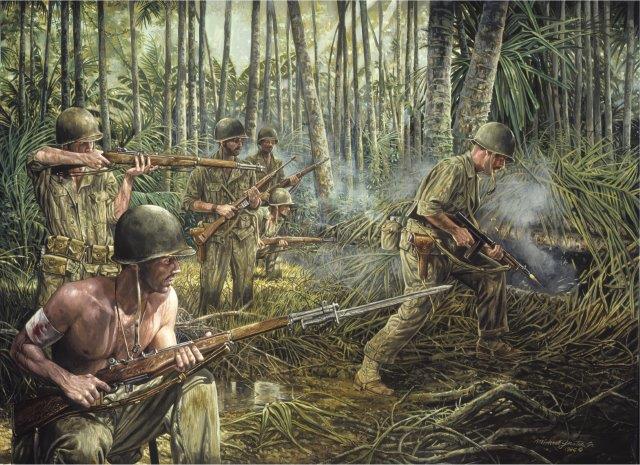 Red Arrow at War by Michael Gnatek for the state of Wisconsin, 1942.
Red Arrow at War by Michael Gnatek for the state of Wisconsin, 1942.
The 32nd Infantry Division, known as the "Red Arrow" Division and made up of units from the Michigan and Wisconsin National Guards, was mobilized on Oct. 15, 1940. Slated to depart for Northern Ireland after World War II began, the division was diverted to the Pacific at the last minute, arriving in Australia in May 1942.
Elements moved to Port Moresby, New Guinea, in September 1942, in order to halt the Japanese invasion which threatened Australia. The Red Arrow's 126th Infantry Regiment went by ship; the 128th Infantry was airlifted in the first mass troop movement by air in World War II. Joining the Australians, the 32nd entered combat on Nov. 16, 1942. The allied forces were to take heavily-fortified Japanese positions at Buna, on New Guinea's southeast coast. It proved to be one of the most difficult campaigns of the war.
Fighting in the hot, steamy jungles, the 32nd was desperately short of basic equipment, weapons, medicine and even food. In the terrible heat and drenching rain, the men of the 32nd -- many burning with fever -- had to reduce Japanese positions one at a time, usually by rushing them with grenades. Most of the Japanese fought to the death but, finally, on Jan 2, 1943, Buna fell. It was the Japanese army's first defeat in modern history, but for the 32nd Division the cost was high: 1,954 were either killed or wounded, with 2,952 hospitalized due to disease. After Buna, the 32nd participated in the long campaign to drive the Japanese from the rest of New Guinea, and went on to see heavy fighting in the Philippines. Today, the 32nd Infantry Brigade, Wisconsin Army National Guard, continues to maintain the Red Arrow heritage.
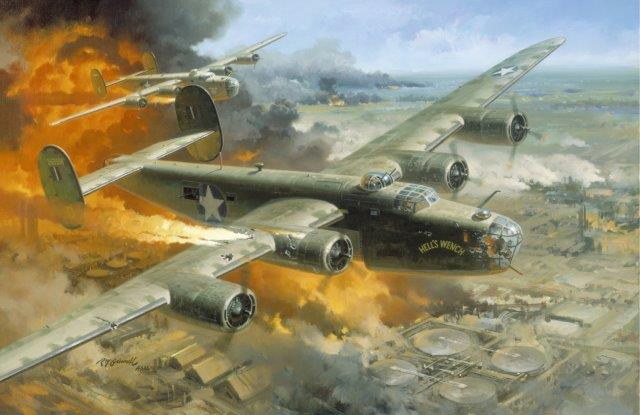 Fire Over Ploesti by Roy Grinnell for the state of Ohio, 1943.
Fire Over Ploesti by Roy Grinnell for the state of Ohio, 1943.
"Hell's Wench," a B-24 badly damaged by anti-aircraft artillery fire, led the 93rd Bombardment Group (Heavy) in its daring low-level attack on the oil refineries at Ploesti, Romania, which supplied two-thirds of Germany's petroleum production at that stage of World War II. Lt. Col. Addison E. Baker, an Ohio National Guardsman who commanded the 93rd, ignored the fact he was flying over terrain suitable for safe landing.
He refused to break up the lead formation by landing, and led his group to the target upon which he dropped his bombs with devastating effect. Then he left the formation, but his valiant attempts to gain enough altitude for the crew to escape by parachute failed and the aircraft crashed. For their gallant leadership and extraordinary flying skill, both Baker and his pilot, Maj. John L. Jerstad, received the Medal of Honor, posthumously.
The raid, nicknamed "Operation Tidalwave," was costly, with 54 of the 177 bombers lost and 532 of the 1,726 personnel engaged listed as dead, missing or interned. Baker's service epitomized the role of National Guard aviators during World War II. Because of their experience, most of them were transferred from their 29 pre-war observation squadrons after mobilization. As individuals, they helped train and lead the huge numbers of volunteer airmen who served in Army Air Force units during the war. Baker and other Guard aviators carried on a long tradition of dedicated service to the states and nation.
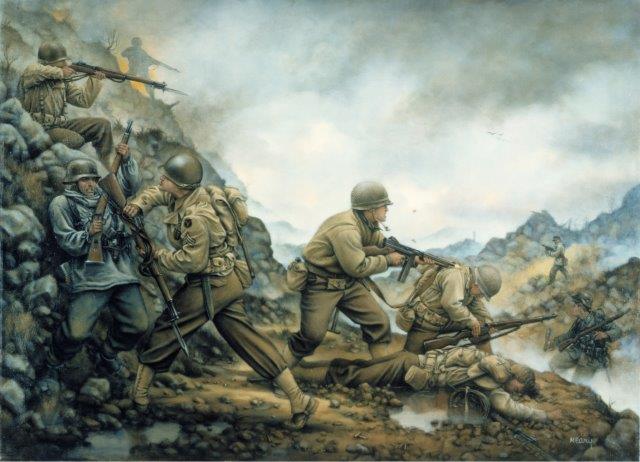 The Red Bull in the Winter Line by Donna Neary for the state of Iowa, 1943.
The Red Bull in the Winter Line by Donna Neary for the state of Iowa, 1943.
In September 1943 the Allies invaded the southern Italian mainland at Salerno. Strategic planners had believed that the Germans would then withdraw north, toward the Alps. But the Germans did not withdraw, and in what became known as the Battle of the Winter Line, the Allies began their long fight up the Italian peninsula. Iowa's 168th Infantry landed at Salerno some three weeks after the initial invasion.
Part of the 34th Infantry Division (Red Bull) from Iowa, Minnesota, and South Dakota, and the first U.S. Army division to arrive in Europe, the 168th Infantry was already a veteran of the North African campaigns. In Italy, the regiment went into action almost immediately, and on November 28, 1943, the 1st Battalion was directed to seize Mount Pantano, a large mountain whose four knobs gave it a square shape. Situated in a draw between the four knobs, was a full battalion of German defenders.
Taking the first knob from the surprised Germans, Company A repulsed an almost immediate counter attack in hand-to-hand fighting. The rest of the battalion arrived and for the next five days the men were under constant attack. Company A's commander, although wounded three times, led a bayonet charge against a German breakthrough; Company B stopped seven German assault waves; grenade duels raged all around the perimeter. When their ammunition was exhausted, the Americans hurled rocks and C-ration cans at the Germans. Because pack mules could only travel one-third of the way up the steep and rain-soaked slopes, supply was a critical problem. For two days there was nothing to drink but rainwater.
To evacuate a casualty meant four to six hours on foot down the steep trail, under mortar fire, which forced the battalion surgeon to treat casualties on the actual firing line. Despite the constant attacks, severe casualties, cold weather and lack of ammunition and food, the 1st Battalion, 168th Infantry held its position for five days until it was relieved. For its gallantry, the unit was awarded the Presidential Unit Citation. This was not the last Italian hillside the 168th and its sister regiments would take from the Germans: the 34th Infantry Division spent the rest of the war in Italy, and is credited with more actual days in combat than any other U.S. Army division. Today, the heritage of the "Red Bull" Division is perpetuated by the 34th Brigade, 47th Infantry Division, Iowa Army National Guard.
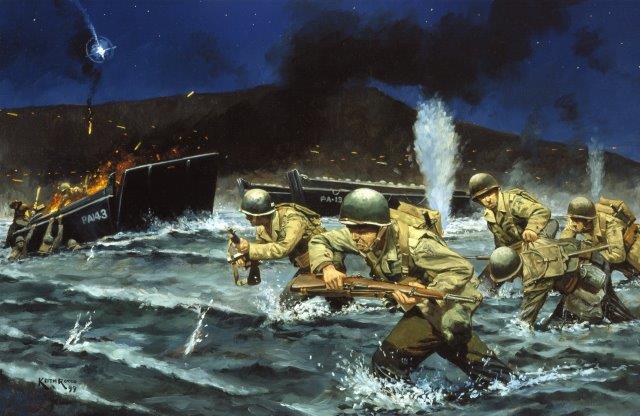 Tip of the Avalanche by Keith Rocco for the state of Texas, 1943.
Tip of the Avalanche by Keith Rocco for the state of Texas, 1943.
The U.S. Army's longest World War II campaign began in Italy on September 9, 1943, when the Texas National Guard's 36th Infantry Division landed at Salerno, south of Naples. Operation AVALANCHE was the first Allied thrust onto the European continent. The "Texas" Division, federalized in November 1940, shipped out two and a half years later for North Africa.
The "T-Patchers" did not take part in the Sicily campaign of July-August 1943, but instead were selected as the American VI Corps' assault division for AVALANCHE. On September 3rd, the British Eighth Army landed at Calabria on the toe of the Italian boot. Allied planners hoped that this would pull the Germans south, away from the main landing at Salerno. Over the objections of his naval task force commander, Fifth Army commander Lt. Gen.
Mark Clark vetoed a pre-invasion bombardment in favor of a surprise landing. Unfortunately for the Texans, the Germans saw them coming. Landing craft carrying the first waves of the 141st and 142nd Infantry were 300 yards from shore at about 3:15a.m. when German shells began falling. Landing craft took direct hits, spilling men into the sea; disabled boats created a logjam. Machine gun fire greeted the men who made it to the beach, but in small groups the T-Patchers began fighting their way inland. At 5:30 a.m., much-needed artillery landed, and the 151st Field Artillery and the 143rd Infantry's Cannon Company repulsed an armored attack. During the next two days German attention turned to the British sector, allowing the 36th to consolidate and move inland as reinforcements, including parts of Oklahoma's 45th Division, arrived.
But Kesselring was gathering units for a counterattack, and by September 12th six panzer divisions faced the Allies, whose units were so decimated by the fierce fighting over the next two days that Clark began planning for evacuation. But Allied air superiority, and superb naval gunnery, finally drove the Germans back. Salerno was secured -- but the battle up the mountainous Italian peninsula, where Germans held the high ground, had just begun for the 36th Infantry Division, the first U.S. division to land on the continent of Europe.
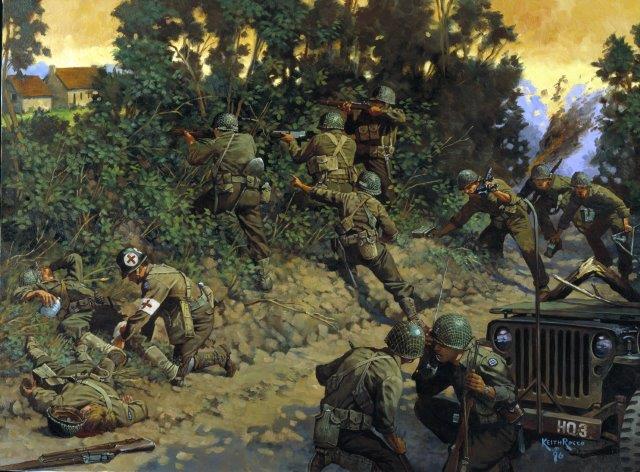 From Cornrow to Hedgerow by Keith Rocco for the states of Kansas, Nebraska and Missouri, 1944.
From Cornrow to Hedgerow by Keith Rocco for the states of Kansas, Nebraska and Missouri, 1944.
Nebraska's 134th Infantry regiment, part of the 35th Infantry Division from Kansas, Nebraska, and Missouri, reported for active federal service in December 1940. Following three years of extensive stateside training, the 134th sailed for England in May, 1944. On 5 July, one month after D-Day, the regiment landed at Omaha Beach and moved swiftly inland with the rest of the 35th Division.
The 134th waited in reserve as the U.S. V and XIX Corps struggled to liberate the vital town of St. Lo. Strong German positions atop Hill 122 north of the city had all but stopped the attack of the combat-weary and understrength 29th Division, which had assaulted Omaha Beach one month before, and the 30th Division, which had been in combat almost as long. On 11 July, the 35th joined in fellow National Guard divisions in the fight for St. Lo and quickly discovered the special difficulties posed by the formidable tangles of rock, earth, and trees called "hedgerows." Used all over Normandy to separate farmers' fields, the Germans had reinforced these natural defensive barriers.
For four days, the 35th Division's 137th and 320th Infantry Regiments made difficult progress against the hedgerows on the lower slopes of Hill 122. On 14 July, the 134th Infantry, commanded by future chief of the National Guard Bureau, Butler B. Miltonberger, received orders to secure the hill. The Cornhuskers began their attack early on 15 July, and after taking the fortified farmhouses in the hamlet of Emilie in fierce fighting, reached the upper slopes of Hill 122 by nightfall.
With the 1st Battalion leading the 134th advanced despite withering small arms and artillery fire. Upon reaching the crest of Hill 122, the Nebraskans repulsed a determined counterattack and supported by other divisional elements, launched a final counterattack of their own. Their capture of this vital hill opened the way for the liberation of St. Lo itself on 18 July. The 134th Infantry had lived up to its Spanish-American War battle cry, "All Hell Can't Stop Us," and the 1st Battalion was awarded the Presidential Unit Citation. But the cost has been high: The regiment suffered 35 percent casualties in two days, including 102 men killed, 589 wounded, and 102 missing.
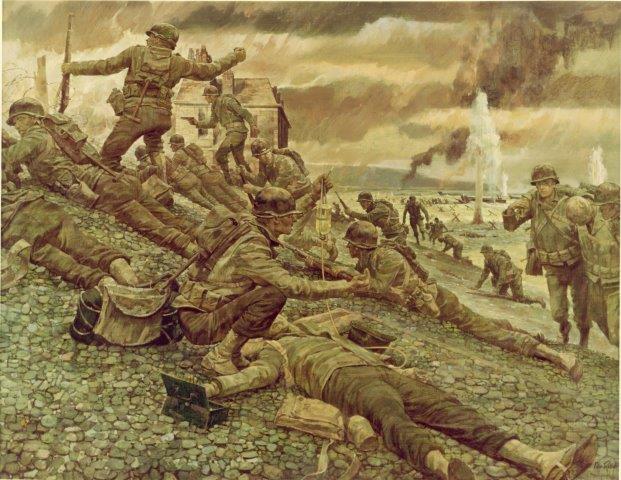 First Wave at Omaha: The Ordeal of the Blue and Gray by Ken Riley for the states of Virginia and Maryland, and The District of Columbia, 1944.
First Wave at Omaha: The Ordeal of the Blue and Gray by Ken Riley for the states of Virginia and Maryland, and The District of Columbia, 1944.
Behind them was a great invasion armada and the powerful sinews of war. But in the first wave of assault troops of the 29th (Blue and Gray) Infantry Division, it was four rifle companies landing on a hostile shore at H-hour, D-Day -- 6:30 a.m., on June 6, 1944.
The long-awaited liberation of France was underway. After long months in England, National Guardsmen from Virginia, Maryland and the District of Columbia found themselves in the vanguard of the Allied attack. In those early hours on the fire-swept beach the 116th Infantry Combat Team, the old Stonewall Brigade of Virginia, clawed its way through Les Moulins draw toward its objective, Vierville-sur-Mer. It was during the movement from Les Moulins that the battered but gallant 2d Battalion broke loose from the beach, clambered over the embankment, and a small party, led by the battalion commander, fought its way to a farmhouse which became its first Command post in France.
The 116th suffered more than 800 casualties this day -- a day which will long be remembered as the beginning of the Allies' "Great Crusade" to rekindle the lamp of liberty and freedom on the continent of Europe.
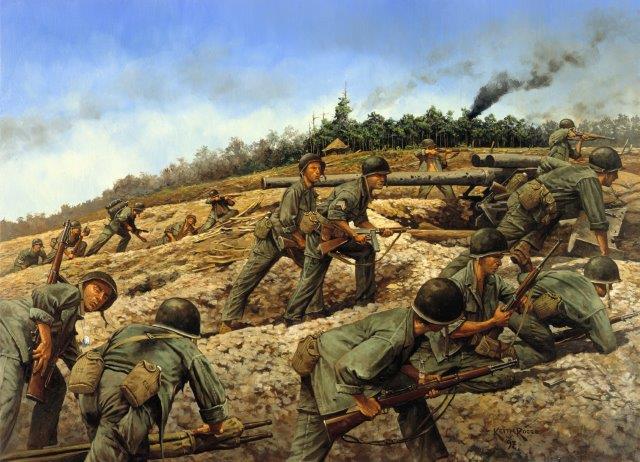 Jungleers on Biak by Keith Rocco for the state of Oregon, 1944.
Jungleers on Biak by Keith Rocco for the state of Oregon, 1944.
In the Spring of 1944, U.S. and Australian forces began "island hopping" to the Philippines, and the airfields on the island of Biak were the first U.S. objective. Planners forecast a week-long operation, unaware that there were 11,500 Japanese on the island entrenched in large caves which honeycombed Biak's mountainous interior. On May 27, 1944, the experienced veterans of the 41st Infantry Division, made up originally of National Guardsmen from Oregon, Washington, Idaho and Montana, landed unopposed on Biak.
It was a feint: the 41st, which had earned its "Jungleer" nickname in New Guinea, was about to enter its toughest fight of World War II. Oregon's 162nd and 186th Infantry were moving inland toward the airfields when the enemy struck. The 163rd Infantry (Montana) was quickly brought in to join the horrible jungle fighting, where despite the heat and steep terrain, water was rationed to one canteen every 24 hours.
On June 15, I Corps commander Lt. Gen. Robert Eichelberger assumed command, prompting a new plan of attack. On June 16, the 2nd Battalion, 186th Infantry, attacked to close a gap between their regiment and the 162nd. The battalion overran dozens of machinegun nests, log bunkers and even a naval gun, and opened the battle's second phase when they discovered a second major cave system. These caves were not cleared until June 27, and not until August 20 would the fight for Biak be declared over. The brilliant Japanese use of natural defenses foreshadowed later fighting on Pelileu and Okinawa, and as on those more famous islands, the fighting on Biak was costly. Only 10 percent of the Japanese defenders survived; the U.S. suffered some 400 killed and 2,000 wounded in action, most of them from the 41st Division. Today, the proud heritage of the Jungleers is carried on by the 162nd and 186th Infantry Regiments of Oregon's 41st Infantry Brigade, and by Montana's 163rd Infantry and 163rd Cavalry Regiments.
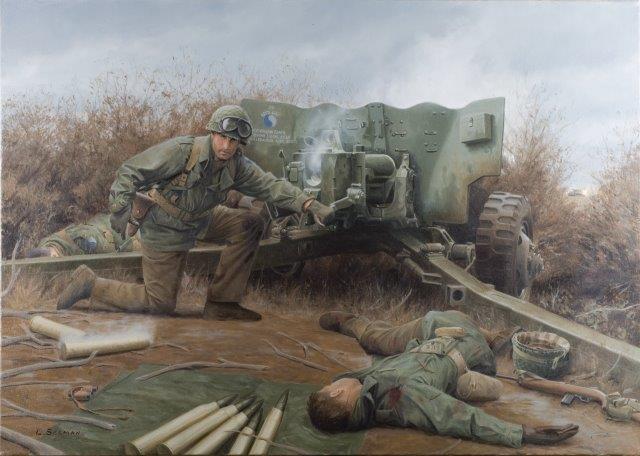 Lightning at Bourheim by Larry Selman for the state of Maryland, 1944.
Lightning at Bourheim by Larry Selman for the state of Maryland, 1944.
Technical Sergeant Joseph A. Farinholt, known as "Lightning Joe" to his buddies, had already earned three Silver Stars in the five and a half months since his unit had landed on Omaha Beach on June 7, 1944. A Guardsman from Baltimore, Maryland, Farinholt was acting platoon leader for the anti-tank platoon of Headquarters and Headquarters Company, 3rd Battalion, 175th Infantry, 29th Infantry Division when he earned his fourth and final Silver Star in late November, 1944.
No known enlisted man in the U.S. Army earned four Silver Stars during the entire war, much less over such a short span of time. On November 26, 1944 the 175th Infantry was spread thin around the outer perimeter of the town of Bourheim, which it had captured three days earlier. For the sixth time in those three days, a German armored column attempted to recapture the town, a key to their defense of the strategic city of Julich on the Roer River.
The enemy attack opened with such an intense artillery barrage that the 29th Division's After Action Report cites as it as "...the worst suffered by the division during the war." Then the German infantry and their supporting tanks pushed forward. Men in the outlying areas fell back toward the town and it looked as though the enemy might finally break through. Farinholt quickly went into action. One of his three 57 mm antitank gun crews, after firing several rounds at the enemy, all became casualties when a German shell hit a tree near their position. Knowing that the 57 mm gun did not have the penetrating power to pierce a Tiger's armor, Farinholt loaded, aimed and fired at the tread of the lead Tiger tank, disabling it and halting the advance of the column. However, the tank returned fire with armor-piercing machine gun bullets, wounding Farinholt in more than 20 places and shattering the bones in his right leg below the knee.
Despite his wounds he managed to drag himself to his jeep and drive to the battalion headquarters to alert them of the strength and direction of the German attack. Weakened by his injuries and unable to control both the clutch and the gas pedal, Farinholt crashed his jeep into the Headquarters building but refused first aid until he gave his report. Because of his actions and those of his platoon, the German advance was stalled for almost an hour and then diverted to another sector, buying time for the 29th Division to move troops and summon air support to successfully defeat the attack. The Germans never recaptured Bourheim. Farinholt's wounds were so severe that he was returned home and spent nearly two years in the hospital.
Though he lived nearly 60 more years, he never fully recovered from his injuries. He is depicted here as he fought the war, with several days' growth of beard, toting his preferred weapon, the M-3 "Grease gun" on his back, and wearing the boots he "liberated" from a dead German soldier in Normandy because they were far more comfortable than the U.S. issue gear. Farinholt's remarkable bravery was emblematic of the courage displayed by over 300,000 National Guardsmen who were called to active duty during peacetime in 1940 and 1941, more then doubling the size of the U.S. Army before America entered World War II. While some 75,000 Guard enlisted men went on to become officers during the war, those who – like Farinholt – remained in the enlisted ranks served an equally valuable role by providing the solid core of experienced non-commissioned officer leadership that every unit needs to be successful in combat.
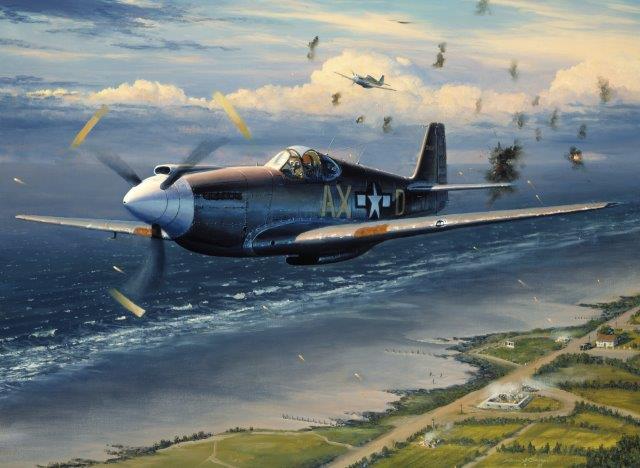 Mission Over Normandy by William S. Phillips for the state of Michigan, 1944.
Mission Over Normandy by William S. Phillips for the state of Michigan, 1944.
The 107th Observation Squadron, Michigan National Guard, one of 29 National Guard observation squadrons, was ordered into active Federal service on October 15, 1940. Along with 4,000 other national Guard Air Corps personnel, the men of the 107th expanded the rapidly-growing U.S. Army Air Forces.
After taking part in antisubmarine patrols, the redesigned 107th Tactical Reconnaissance Squadron deployed to England in August 1942. They flew L-4, L-5, A-20 and Spitfire aircraft, before being equipped with the F-6A, the reconnaissance version of the P-51 Mustang. In December 1943, the 107th became the first operational photographic reconnaissance squadron in Northern Europe.
In preparation for the Allied invasion, the squadron flew missions over the French coast and was awarded the Presidential Unit Citation for its efforts. Assigned to support the First U.S. Army during the Normandy Campaign, the 107th was the first reconnaissance unit to operate from French soil. The 107th achieved an illustrious record during World War II, a record which is proudly maintained by the 107th Tactical Fighter Squadron, Michigan Air National Guard.
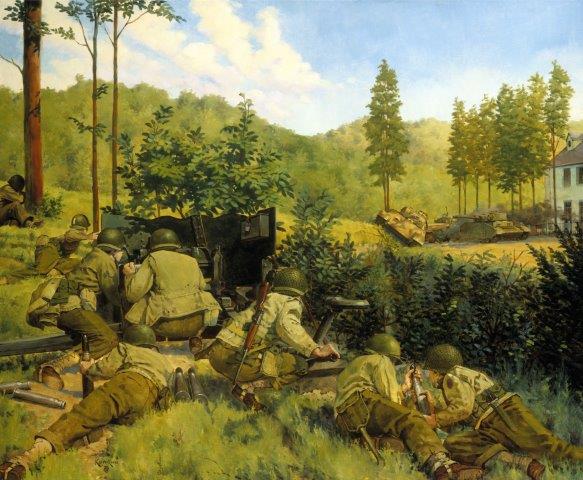 The Battle of Mortain by Keith Rocco for the states of North Carolina, South Carolina and Tennessee, 1944.
The Battle of Mortain by Keith Rocco for the states of North Carolina, South Carolina and Tennessee, 1944.
In August 1944, after the Normandy invasion of June and subsequent breakout at St. Lo, in July, the German High Command was prepared for a massive counter-offensive in an attempt to throw the Allied Armies back into the sea. Hitler, and his generals, moved massive amounts of armor and infantry to the area of Mortain, France, 150 miles west of Paris.
At H-Hour, 7 August 1944, the troops of the XLVII Panzer Corps rolled forward in Operation Luttich with the 2nd SS Panzer Division headed directly for Mortain and Hill 317, a key terrain feature in the central sector of the attack, Above are depicted part of the Anti-tank Company, 3rd Battalion, 120th Infantry Regiment, 30th Infantry Division (N.C., S.C., Tenn.) during fighting on the second day. They had set up a roadblock adjacent to Hill 317, where the 2nd Battalion, 120th Infantry was dug in directly north of Mortain.
The crews, manning the 57mm anti-tank guns, and troops of the 2nd Battalion with anti-tank rockets, were responsible for destroying over 40 vehicles during the action and stopped the German onslaught in the area. On the 7th of August, the roadblock and Hill 317 were surrounded and bypassed by the main body of German forces. The group surrounded on Hill 317, commanded by Capt. Reynold Erichson -- about 700 men -- were protected by a ring of artillery fire from the 35th Infantry Division artillery and fighter-bomber sorties flown by the 2nd Tactical Air Force RAF. This kept the Germans from taking Hill 317 and stopped the momentum of the counterattack in the area on the first day. The 35th Infantry Division, attacking the German penetration from the southwest, relieved the besieged troops at noon on 12 August. In one of the outstanding small-unit achievements of the war in Europe, the defenders held out for six days, sustained 300 casualties, but denied the enemy a key objective. For their valiant actions on Hill 317, the 120th Infantry Regiment was awarded a Presidential Unit Citation. This proud fighting tradition of the 30th Infantry Division is perpetuated by the 30th Infantry Brigade, North Carolina Army National Guard.
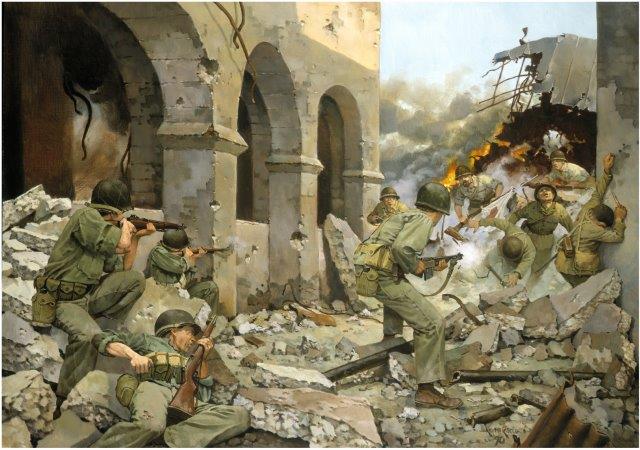 Manila Would Do by Keith Rocco for the state of Ohio, 1945.
Manila Would Do by Keith Rocco for the state of Ohio, 1945.
The 37th division, Ohio National Guard was mobilized prior to World War II on October 15, 1940. The "Buckeyes" Division was sent to the South Pacific in May of 1942 where its three infantry regiments, the 129, 148th, and 149th all distinguished themselves in the tough fighting on Rendova island and Bougainvilla.
The division landed at Lingayan Gulf, on the Philippine Island of Luzon, January 9, 1945, and after almost a month of fighting took part in the assault of Manila, entering the city on the 4th of February. The soldiers of the 37th Infantry Division secured the Old Bilibid Prison freeing 1330 civilian internees and military prisoners of war. They made an assault crossing of the Pasig River, cleared the Paco neighborhood, and reduced the Intramuros fortress. The Japanese fortified buildings with skill and the larger reinforced concrete buildings became major obstacles to the men of the 37th. Casualties mounted.
The Japanese held not only the access to the buildings, but also fought from inside the buildings themselves, forcing the 37th to fight not only block by block or building by building, but floor by floor and room by room. This was the kind of fighting that placed a premium on a good leadership at squad and platoon levels. Many junior officers and non commissioned officers led by example. A squad leader in the 148th Infantry was the object of a bayonet charge by six Japanese soldiers who charged from approximately 30 yards away. Sergeant Billy E. Vinson warded off the first Japanese soldier's bayonet thrust, then dispatched the assault group with one long burst from his Browning automatic Rifle. He held his forward position until all wounded soldiers in the vicinity could be evacuated. After weeks of hard fighting, Manila was secured on the 2nd of March, 1945. As the 37th Infantry Division history states, "For those who missed Normandy or Cassino, Manila would do." The courage and spirit of the fighting soldiers of the 37th Division is carried on today by the dedicated soldiers of the Ohio National Guard.
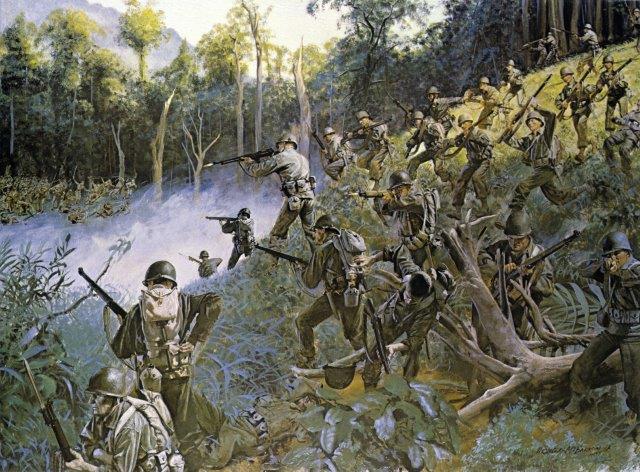 "Cuidado"--Take Care--Bushmaster with Bolo! by H Charles McBarron for the state of Arizona, 1945.
"Cuidado"--Take Care--Bushmaster with Bolo! by H Charles McBarron for the state of Arizona, 1945.
Cries of "Banzai" rang through the snake infested jungles while the staccato of enemy machine guns, mortars and rifles rolled. The bayonet charges were suicidal but the 158th Regimental Combat Team, the "Bushmasters," repulsed the enemy and advanced. It fought day after day, in critical battles to open the Visayan passages for allied shipping in the Pacific.
The merciless campaign lasted two months in terrain laced with tank traps, wire, mines and bamboo thickets. This proud Arizona National Guard unit, organized as the Arizona Volunteer Infantry for the Indian campaigns in 1865, wore its motto, "Cuidado," - Take Care - in jungles six years. Mustering in the great southwestern desert, the unit was mainly "Mexican-American" and North American Indian from twenty tribes.
Expanded in Panama, it was one of World War II's few organizations to complete the trail from there to "down under" to Japan. Its shoulder insignia reflects familiarity with the deadly Panamanian Bushmaster snake and the Philippine machete--the bolo. Today, Headquarters Detachment, 158th Military Police Battalion, Tucson, holds the lineage and honors.
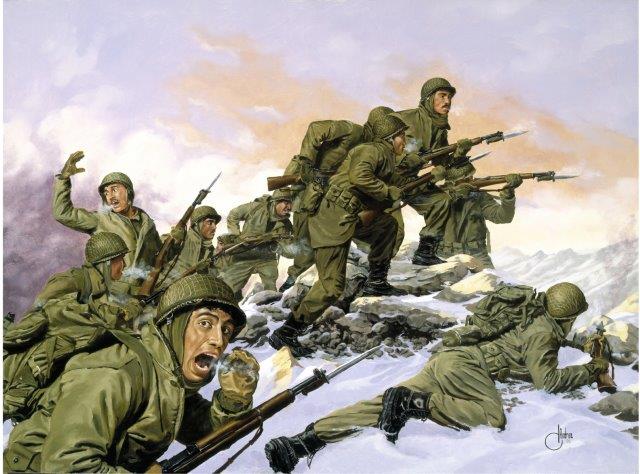 The Borinqueneers by Domenick D'Andrea for the state of Puerto Rico, 1951.
The Borinqueneers by Domenick D'Andrea for the state of Puerto Rico, 1951.
In August 1950 the Korean War was less than two months old, and Puerto Rico's 65th Infantry Regiment was on its way to the combat zone. The regiment landed at the port city of Pusan on the Korean Peninsula's southern tip, where United States forces had been holding a perimeter against the Communist North Korean invaders.
Sent into action immediately, the Puerto Ricans took part in the United States breakout and drive to the north. Following the brilliantly planned and executed surprise landings at Inchon, United States and other United Nations forces drove deep into the mountains of North Korea. At that point a huge Chinese Army entered the war. The United States Eighth Army was overrun, and the 1st Marine Division, with attached United States and British Army units, was completely encircled.
In one of the greatest fighting retreats in history, the outnumbered marines battled their way south to the coast. The first friendly troops they saw on the frozen ridgetops were the Puerto Ricans of the 65th Infantry Regiment, sent to hold the perimeter around the vital port of Hungnam. The Puerto Ricans supervised the evacuation of Hungnam, finally sailing themselves on Christmas Eve, 1950. The 65th landed in Pusan as they had five months before, and again fought their way northward. Late January 1951 found them south of the Korean capital of Seoul, under orders to take two hills being held by the Chinese 149th Division. The assault began on January 31st, and took three days.
On the morning of the third day the top of the hills were within reach, and two battalions of the 65th fixed bayonets and charged straight at the enemy positions. The Chinese fled. During its service in Korea, the men of the 65th Infantry won four Distinguished Service Crosses and 125 Silver Stars. The "Borinqueneers" were also awarded the Presidential and Meritorious Unit Commendations, two Korean Presidential Unit Citations and the Greek Gold Medal for Bravery. The 65th Infantry Regiment's gallant service in a difficult war is exemplified by its regimental motto, "Honor and Fidelity," and the regiment itself exemplifies the National Guards leading role in our nation's military history.
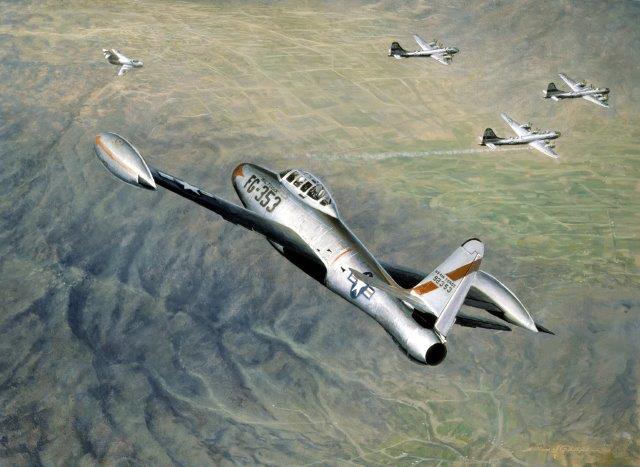 Air Guard in MIG Alley by William S. Phillips for the state of Texas, 1951.
Air Guard in MIG Alley by William S. Phillips for the state of Texas, 1951.
During the Korean War over 45,000 Air Guardsmen, in 22 wings and other units, were called into active Federal service. The 136th Fighter-Bomber Wings, Texas ANG, was among the first Air National Guard units to be called. Flying the F-84E Thunderjet, the Texas Guardsmen moved to Japan in May 1951 and, shortly thereafter, became the first Air Guardsmen to enter combat in the Korean War. During the winter and spring of 1951, the Chinese Communist Air Force mounted a major air offensive against the United Nations air forces.
The major contested area were the skies over northwestern Korea known as "MIG Alley." The U.S. Air Force retaliated by mounting a counteroffensive aimed at destroying the enemy's aircraft and bases. In June 1951 the 136th's 182d Fighter-Bomber Squadron was given the mission of protecting B-29 flights on bombing missions over North Korea. On June 26, 1951, the pilots of the 182d were escorting four B-29s to an enemy airfield near Yongyu when five MIG-15s attacked the American bombers.
Although relatively new to combat, the pilots of the 182d turned back the veteran MIG pilots. During the ensuing dogfight, 1st Lt. Arthur E. Oligher assisted by Capt. Harry Underwood, shot down a MIG-15--the first Air Guard jet "kill." The Air National Guard went on to make an impressive combat flying record. Today's 182d Tactical Fighter Squadron, Texas Air National Guard continues to add to its impressive flying record.
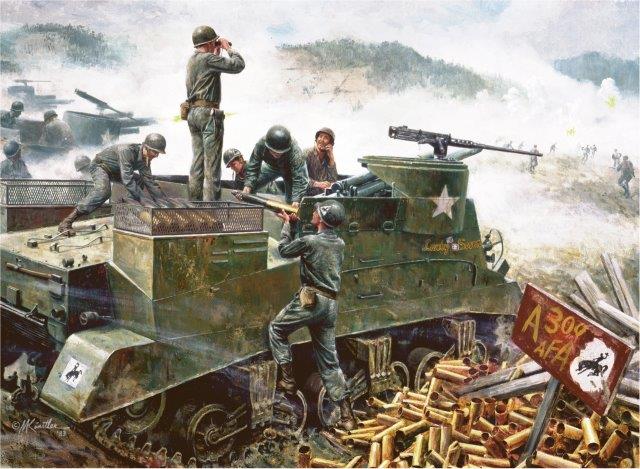 Cowboy Artillery at Soyang by Mort Kunstler for the state of Wyoming, 1951.
Cowboy Artillery at Soyang by Mort Kunstler for the state of Wyoming, 1951.
Among the hundreds of Army National Guard units ordered into active Federal service as a result of the Korean War was the 300th Armored Field Artillery Battalion, Wyoming Army National Guard. The battalion arrived in Korea in February 1951 and entered combat in early May.
On the night of May 15, 1951, three corps of the Chinese People's Volunteers launched a major offensive against the 2nd Infantry Division. The 300th Armored Field Artillery Battalion, attached to the 2nd Division during the Battle of Soyang, delivered devastating artillery fire for seven days inflicting thousands of enemy casualties.
During the morning of May 18 the battalion was given the mission of destroying an enemy roadblock. The batteries of the 300th poured both direct and indirect fire on the road block allowing retreating U.N. forces to fall back to more secure positions.
The heroic and determined stand of the 2nd Division and its attached units allowed the Eighth Army to regroup and stop the enemy envelopment. For its gallantry in action, the battalion was awarded the Presidential Unit Citation, the first of four awards that the 300th would earn. Today's 1st and 3rd Battalions, 49th Field Artillery, Wyoming Army National Guard carry on the gallant traditions of the Cowboy Artillery.
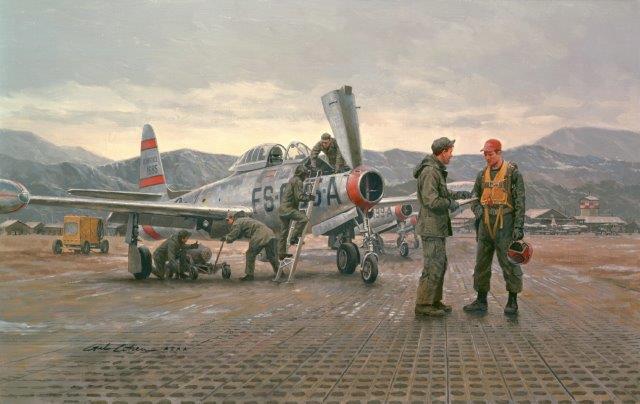 Mission from Taegu by Gil Cohen for the state of Georgia, 1951.
Mission from Taegu by Gil Cohen for the state of Georgia, 1951.
The 158th Fighter Bomber Squadron (FBS) of the Georgia Air National Guard (ANG) was mobilized in October 1950. After converting from F-80Cs to F-84Es, the unit moved to Japan in July 1951. It was one of six mobilized Air Guard fighter squadrons that saw combat in the Far East during the Korean War.
Stationed at Misawa Air Base, the 158th deployed for short periods of time to the austere forward operating location at Taegu Air Base in the Republic of Korea where it concentrated on flying dangerous ground attack missions against enemy supply lines and troops in the field. Starting in February 1952, the 158th also participated in Operation High Tide, an experimental combat air-refueling project conducted by the Air Force.
In July 1952, the unit left federal service and returned to state control after completing its required 21 months of active duty. In addition to the 158th, the other Air Guard fighter units that flew combat missions in Korea included: the 111th FBS, Texas; 154th FBS, Arkansas; 159th FBS Florida; 182nd FBS, Texas; and 196th California. Pilots assigned to the six fighter Air Guard units plus ANG aviators serving in regular Air Force squadrons flew 39, 530 combat sorties in Korea. They destroyed 39 enemy aircraft and four of them became aerial aces. However, the cost was high with 101 Air Guardsmen either killed or declared missing in action.
Korea was the Air Guard's first and largest war as a reserve component of the Air Force. Over 45,000 Air Guardsmen, 80 percent of the force, were called into federal service. Altogether, 67 of the Air Guard's 84 combat flying squadrons were mobilized. Those ANG flying units not deployed to Korea were either dispatched to buildup NATO in Europe or assigned to major air commands in the United States to strengthen the Air Force for a possible global military confrontation with the Soviet Union. During the Korean War period, mobilized Air Guard units operated a wide variety of aircraft including F-47s, F-51s, B-26s, B-29s, RB-29s, RB-36s, B-45s, F-80s, F-84s, and F-86s.
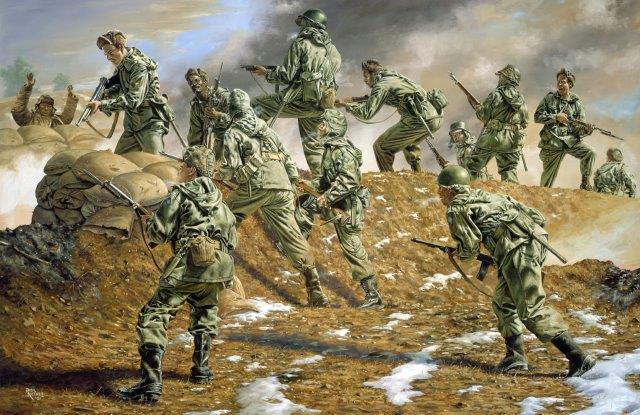 The Sunshine Division in Korea by Rick Reeves for the state of California, 1952.
The Sunshine Division in Korea by Rick Reeves for the state of California, 1952.
After North Korea invaded South Korea on 25 June 1950, United States armed forces fought to repel Communist aggression. President Harry Truman and his advisors, not wanting the conflict to escalate into World War III, had major concerns about mobilizing reserve forces, but ultimately decided that it was a military necessity and authorized mobilization in 19 increments beginning in July 1950.
Hundreds of Army and Air National Guard units were mobilized, including the 40th Infantry Division of the California Army National Guard. The "Sunshine Division" mustered into Federal service 1 September 1950 at Camp Cooke, later renamed Vandenberg Air Force Base, California. The 40th Division deployed to Japan in the spring of 1951 and trained there for months while senior Army commanders debated employing the division in Korea as a unit or as individual replacements.
Eventually, in January 1952, the 40th arrived in Korea and relieved the 24th Infantry Division in place, assuming control of its positions and equipment. By 1952 the war had evolved into static defensive combat of trench and bunker warfare and small unit patrolling. The 40th Division fought mostly in platoon and company actions in the Kumsong and Kumwha Valley sectors. Though relatively minor compared to earlier battles in Korea, these small unit actions were often violent and intense. Because of the delays in deploying to Korea, many of the original California Guardsmen began to rotate home in the Spring of 1952 and were replaced by draftees.
By July only a few Guardsmen remained in Korea. The 40th fought at Heartbreak Ridge and was defending the northern edge of the "Punchbowl" as the armistice came in July 1953. Today's 40th Infantry Division of the California Army National Guard carries the Lineage and Honors of the "Sunshine Division" from the Korean War.
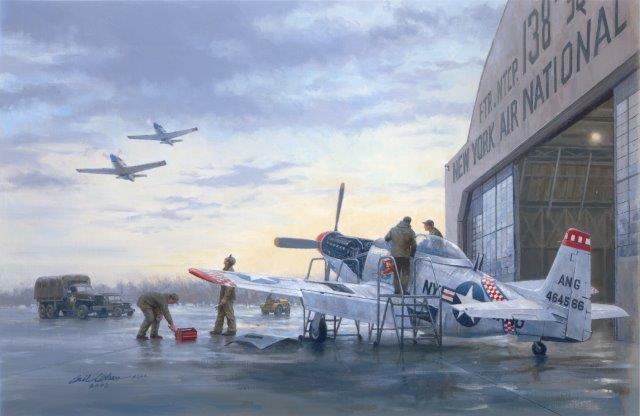 Runway Alert, Foundation of the Total Force by Gil Cohen for the states of California and New York, 1953.
Runway Alert, Foundation of the Total Force by Gil Cohen for the states of California and New York, 1953.
Beginning March 1, 1953, the Air National Guard's (ANG's) 138th Fighter Interceptor Squadron at Syracuse, New York and its 194th Fighter Bomber Squadron at Hayward, California each maintained two F-51D fighters and five pilots on five-minute air defense runway alert from one hour before sunrise to one hour after sunset.
The experiment was the brainchild of Georgia Air Guardsman and former Chief of the Air Division, National Guard Bureau, Major General George Finch. It sought to aid the Air Force's hard pressed Air Defense Command (ADC) in defending the continental United States against the threat of Soviet air attacks, maintaining the nation's air sovereignty by intercepting unidentified aircraft entering its airspace, and providing simulated fighter attacks against the Strategic Air Command's nuclear-capable bombers.
The experiment provided badly needed additional training opportunities for ANG fighter pilots. Despite serious Air Force doubts about its effectiveness and legality, the experiment was a great success and was placed on a permanent basis in August 1954. By 1961, 25 ANG fighter squadrons were participating in ADC's runway alert program on an around-the-clock basis. During the 1990s, the ANG assumed the entire responsibility for providing units to perform the Air Force's continental air defense and air sovereignty missions including its command and control functions at 1st Air Force. More significantly, the runway alert experiment was the first broad effort to integrate reserve units into a major Air Force combat mission in peacetime on a continuing basis. It provided one of the central organizing principles for the Department of Defense's total force approach to reserve components training and utilization which was adopted in the 1970s.
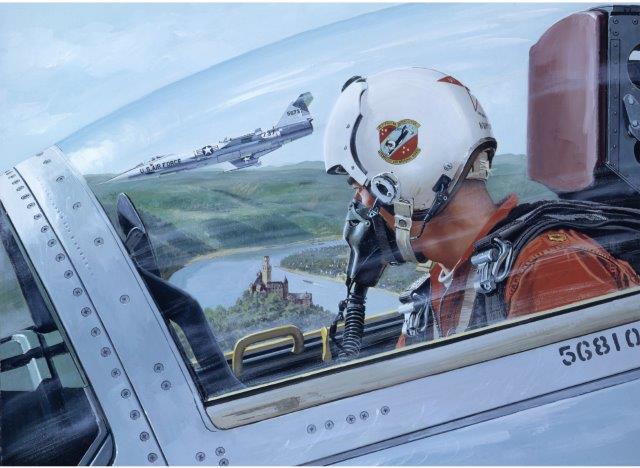 Watch Over the Rhine by Ed Valigursky for the state of Tennessee, 1961.
Watch Over the Rhine by Ed Valigursky for the state of Tennessee, 1961.
As the Russians tightened their grip on West Berlin, and events appeared to be escalating toward a nuclear showdown in the world, President John F. Kennedy dramatized America's determination by mobilizing 65,460 officers and men of the Army and Air National Guard. Less than 30 days after the mobilization, citizen-airmen of the Air National Guard flew 216 fighter and reconnaissance jet aircraft swiftly and smoothly across the Atlantic in the largest mass deployment of jets in the nation's history.
The prompt reaction represented the greatest display of National Guard readiness ever. In a modern version of the "Watch on the Rhine," the Air Guardsmen continued patrolling the skies over Europe until their demobilization a year later. Protecting the NATO nations from surprise attack, the Guardsmen wrote into the record a clear-cut example of the deterrent power of our 20th Century Minutemen, the combat-ready forces of the Air National Guard.
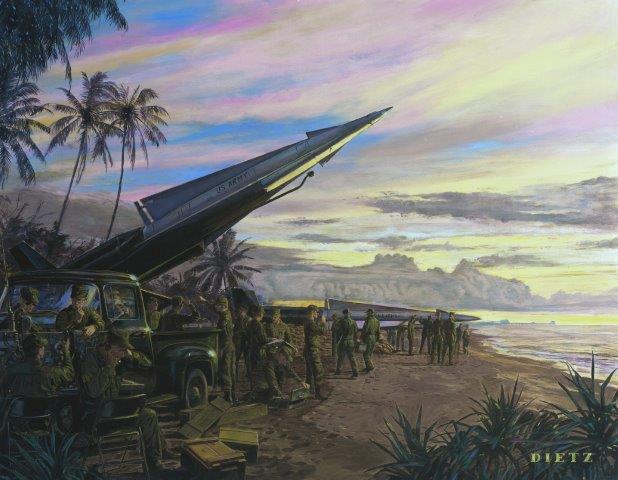 Live Fire at Kahuku by Jim Dietz for the state of Hawaii, 1966.
Live Fire at Kahuku by Jim Dietz for the state of Hawaii, 1966.
With the onset of the Cold War and the threat of long-range Soviet nuclear bombers, the Guard wrote a new page in its long history of homeland defense. Beginning in 1954, thousands of Army Guardsmen manned antiaircraft artillery positions across the country, adopting for the first time a Federal mission while in a State status.
In the late 1950s, the Guard began transitioning from guns to the longer-ranged and more lethal missiles. For exactly sixteen years, from September 14, 1958 to September 14, 1974, the Army National Guard manned Nike-Ajax and Nike-Hercules missile batteries in an operational status. At the height of the program in 1969, seventeen states (California, Connecticut, Hawaii, Illinois, Maryland, Massachusetts, Michigan, Missouri, New Jersey, New York, Ohio, Pennsylvania, Rhode Island, Texas, Virginia, Washington and Wisconsin) provided more than 7,000 soldiers to man 54 missile batteries around sixteen key metropolitan areas.
The Hawaii National Guard's 298th Artillery Group was the first National Guard unit to adopt the Nike-Hercules missile, becoming operational on-site in early 1960. Hawaii was also the only state to man all of its firing batteries with Guardsmen; in the continental United States the Guard manned about a third of all Nike sites. While the rest of the Nike force conducted its annual practices at McGregor Guided Missile Range in New Mexico, the Hawaii Guard was unique in that it conducted its annual live-fire certifications from mobile launchers firing off the north shore of the island of Oahu. It was during just such a live-fire that Battery B, 1st Missile Battalion, 298th Artillery Group recorded the longest successful Nike-Hercules missile intercept of a target.
The advent of Intercontinental Ballistic Missiles led to major cutbacks in the Nike program in 1971 and its termination in 1974. Though no missile was ever fired in anger, the duty encompassed a 24 hour watch, 365 days a year, and thousands of alerts. Guardsmen had demonstrated their ability to conduct real-world missions while in a part-time, state-controlled status, in the process proudly adopting for themselves the title "Missile-Age Minutemen."
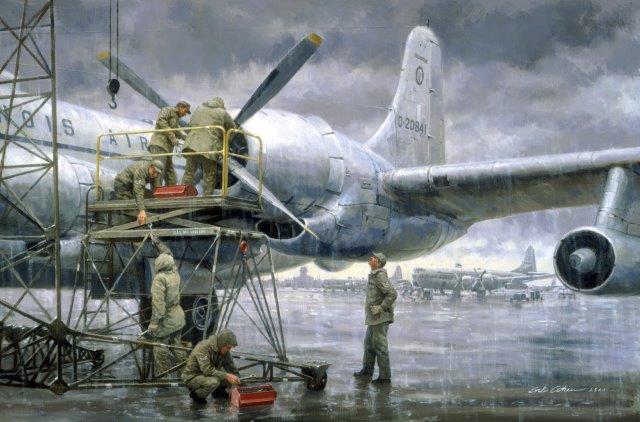 Operation Creek Party by Gil Cohen for the state of Illinois, 1967.
Operation Creek Party by Gil Cohen for the state of Illinois, 1967.
Mechanics from the 126th Air Refueling Wing (ARW), Illinois Air National Guard, deployed to Rhein-Main Air Base, Germany, during Operation Creek Party, prepare a KC-97L tanker for a mission. Creek Party provided in-flight refueling services for fighter aircraft assigned to the U.S. Air Forces in Europe for 10 consecutive years. Enlisted Guardsmen, working in austere conditions, usually outdoors, at Rhein-Main, played a vital role in sustaining their aging KC-97L aircraft.
In addition to providing a template for volunteerism in real-world missions outside the continental United States, the latter stages of Creek Party marked the initial inclusion of small numbers of African-Americans in critical aircraft maintenance specialties within the Air Guard's tanker community. The Air Guard had been called upon for help by the Air Force because the latter's tanker assets were overtaxed while supporting the Strategic Air Command's nuclear alert mission and the growing requirements of the Vietnam War.
Creek Party was the earliest known sustained overseas volunteer rotation by a Reserve component of the U.S. armed forces to support a real-world military mission in a situation short of war. In addition to the 126th ARW, aircraft and personnel from the following Air National Guard units shared responsibility for the operation: 126th Air Refueling Group (ARG), Illinois; 128th ARG, Wisconsin; 134th ARG, Tennessee; 136th ARG, Texas; 136th ARW, Texas; 139th ARG, Missouri; 151st ARG, Utah; 160th ARG, Ohio; 161st ARG, Arizona; 171st ARG, Pennsylvania; and the 171st ARW, Pennsylvania.
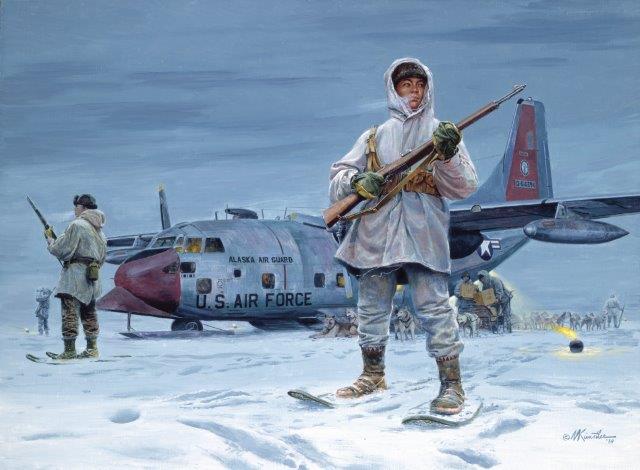 Guardians of the North by Mort Kunstler for the state of Alaska, 1968.
Guardians of the North by Mort Kunstler for the state of Alaska, 1968.
Since the 17th century, the National Guard has provided units for the first-line defense of the nation. The Scout Battalions of the 297th Infantry, Alaska Army National Guard, composed mostly of Eskimos, continue this historic mission. Supported by the 176th Tactical Airlift Group, Alaska Air National Guard, the Scout Battalions patrol the vast Alaskan tundra.
The battalions were organized during World War II and given the mission of providing early warning in case of an enemy landing. Just as they have done since 1942, the Scouts operate from small villages in Northern and Western Alaska, constantly observing the Bering Sea coastline and often providing significant intelligence information.
Like their colonial predecessors, the Scouts of the 297th Infantry and the airmen of the 176th Tactical Airlift Group continue to defend their community, state, and nation.
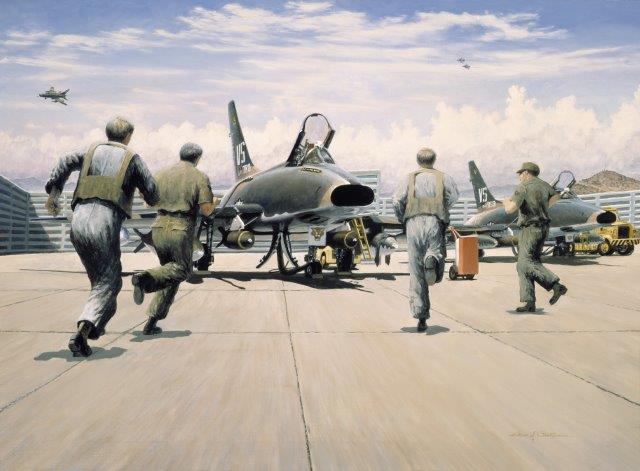 Scramble at Phan Rang by William S. Phillips for the states of Colorado, New Mexico and New York, 1968.
Scramble at Phan Rang by William S. Phillips for the states of Colorado, New Mexico and New York, 1968.
The 120th Tactical Fighter Squadron, Colorado Air National Guard, arrived at Phan Rang Air Base, South Vietnam, during the concluding days of the second Viet Cong offensive of 1968.
The squadron was ordered into active federal service as a result of the Pueblo incident in January 1968, along with three other F-100 tactical fighter squadrons: 136th Tactical Fighter Squadron, New York, 174th Tactical Fighter Squadron, Iowa, 188th Tactical Fighter Squadron, New Mexico. The 120th Tactical Fighter Squadron entered combat on 5 May 1968, two days after its arrival, and completed its 1,000th mission 51 days later.
During the Air National Guards eleven months of service in Vietnam, the four F-100 squadrons flew 24,124 combat sorties and accumulated 38,614 combat flying hours. The Air Guards record proved, once again, the combat-ready status and professionalism of the Air National Guard.
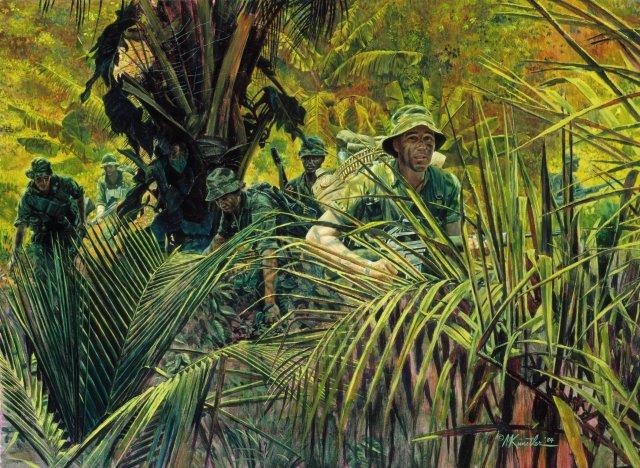 Indiana Rangers: The Army Guard in Vietnam by Mort Kunstler for the states of Indiana, 1969.
Indiana Rangers: The Army Guard in Vietnam by Mort Kunstler for the states of Indiana, 1969.
On May 13, 1968, 12,234 Army National Guardsmen in 20 units from 17 states were mobilized for service during the Vietnam War. Eight units deployed to Vietnam and over 7,000 Army Guardsmen served in the war zone. Company D (Ranger), 151st Infantry, Indiana Army National Guard arrived in Vietnam in December 1968. As part of the II Field Force, the Indiana Rangers were assigned reconnaissance and intelligence-gathering missions.
Operating deep in enemy territory, Ranger patrols engaged enemy units while conducting raids, ambushes and surveillance missions. "Delta Company" achieved an impressive combat record during its tour in Vietnam; unit members were awarded 510 medals for valor and service. The gallant record of Company D, 151st Infantry symbolizes the Army National Guard's performance in Vietnam.
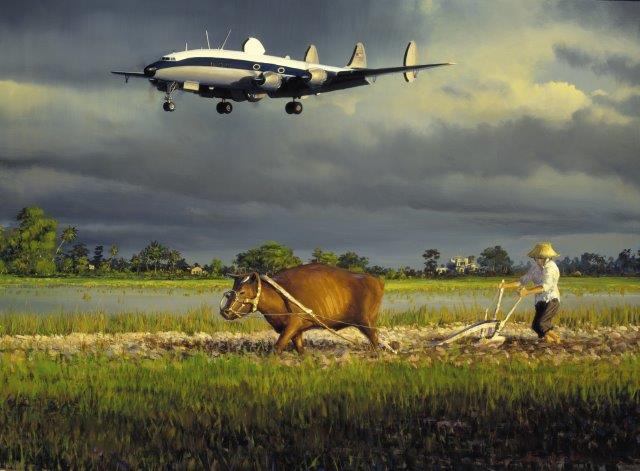 Operation Commando Buzz by William S. Phillips for the state of Pennsylvania, 1970.
Operation Commando Buzz by William S. Phillips for the state of Pennsylvania, 1970.
On July 28, 1970, two EC-121 Lockheed "Super Constellations" from the 193d Tactical Electronic Warfare Squadron took off from Olmsted State Airport, Harrisburg, Pennsylvania. United States forces were fighting in Vietnam, and the EC-121s were headed for Korat in the neighboring country of Thailand, 12,000 miles away, where the United States Air Force was operating from a Royal Thai Air Force base.
Korat Air Base would be home for 252 Air Guardsmen for the next six months. The men were rotated as part of Operation Commando Buzz, with approximately 60 officers and airmen at a time serving tours of duty of from 30 to 90 days. In addition to the aircrews and technicians, an additional 75 officers and airmen supported Commando Buzz by flying materiel and personnel from Olmsted to Southeast Asia and back.
The Pennsylvania Air Guard's EC-121s were laden with electronic equipment, and their mission was to act as flying radar stations and airborne control platforms. They possessed search and identification radar, interception equipment, and a battery of communications gear. The range of the EC-121s extended over all of North Vietnam and the Gulf of Tonkin, and they were a key element in Seventh Air Force control of tactical air operations.
The final group of Air Guardsmen rotated during the Thanksgiving and Christmas holidays of 1970, and early in January 1971, the mission was completed. Within three days after the return of the 193d to Pennsylvania the Commander-in-Chief, Pacific Air Forces sent a message to the Chairman of the Joint Chiefs of Staff, commending the dedication and professionalism demonstrated by the exceptional mission performance of the 193d, which won the USAF outstanding unit award that year. The 193d Tactical Electronic Warfare Squadron is today the 193d Special Operations Group, still a proud part of the Pennsylvania Air National Guard.
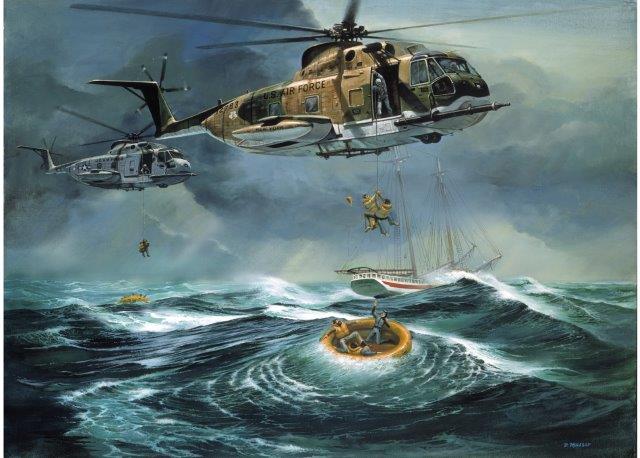 Atlantic Ocean Rescue by Don Millsap for the state of New York, 1977.
Atlantic Ocean Rescue by Don Millsap for the state of New York, 1977.
The John F. Leavitt, the first American commercial sailing vessel built in 40 years, was on its maiden voyage to Haiti with a cargo of lumber when it encountered heavy seas some 280 miles off the coast of Long Island. Battered by 20-foot waves, the cargo broke loose and damaged the hull of the ship.
The crew managed to keep the ship afloat for 24 hours until the morning of Dec. 27, 1979, when the captain radioed for assistance. Two HH-3E Jolly Green Giant helicopters and an HC-130 Hercules from the 106th Aerospace Rescue and Recovery Group, New York Air National Guard, were dispatched for this mission. Preceded by the HC-130, the helicopters arrived to find that the ship's 80-foot masts precluded hoisting the crew from the deck.
Two pararescuemen, Tech. Sgts. Jay Junks and Paul Bellissimo, jumped from the helicopters into the water and boarded the ship to direct the rescue operation. In the last few minutes of daylight, the nine crewmen and the two Guardsmen boarded life rafts and were then hoisted aboard the waiting helicopters. The Air National Guardsmen of the 106th Aerospace Rescue and Recovery Group added yet another chapter to the annals of peacetime heroism by performing a service to their fellow citizens.
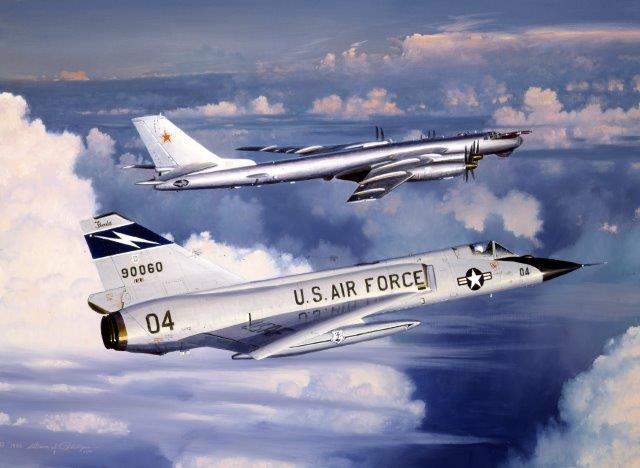 Guarding America's Skies by William S. Phillips for the state of Florida, 1986.
Guarding America's Skies by William S. Phillips for the state of Florida, 1986.
In 1986, an F-106 of the Florida Air National Guard's 125th Fighter-Interceptor Squadron encountered a Soviet Tu-95 "Bear" bomber off the Florida coast. It was a routine encounter for this Air National Guard squadron, and symbolizes a quarter-century of Air Guard participation in the defense of the United States.
In 1953, Air National Guard fighter-interceptor units took on an air defense alert mission, intercepting unidentified aircraft flying into American airspace. Air Guard pilots and aircraft stood alert 24 hours a day. This mission grew each year, and by 1965 the 22 Air Guard fighter-interceptor squadrons flew 30,000 hours and completed over 38,500 intercept sorties.
The Air Guard's role in the air defense mission continued to expand; in 1988 the Air National Guard provided 86% of the Air Force units assigned to air defense. For nearly four centuries the National Guard has defended America. The 159th Fighter Interceptor Squadron, 125th Fighter Interceptor Group, Florida Air National Guard continues the Guard's traditional mission.
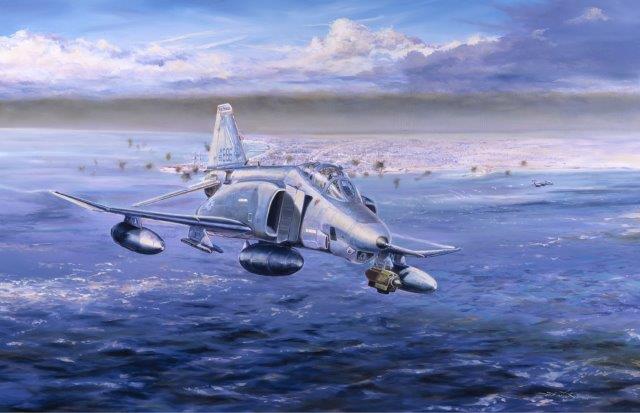 "High Rollers" over Kuwait by Rick Herter for the state of Nevada, 1991.
"High Rollers" over Kuwait by Rick Herter for the state of Nevada, 1991.
Late in the afternoon of January 27, 1991, only ten days after the war between Iraq and the Allied Coalition forces began, aircrews of the 192nd Reconnaissance Squadron, 152nd Reconnaissance Group, Nevada Air National Guard, were called upon to fly north to Kuwait. Their mission was to take pictures of open oil manifolds which were draining crude oil into the Persian Gulf at the order of Saddam Hussein.
Equipped with special sensors which provide highly detailed photographs from long distances, the two RF-4 aircraft from the 192nd took off from SheikIsa Air Base, Bahrain, without fighter escorts. Relying only on their speed and the skills of the aircrews, the "Phantoms" had to enter enemy territory alone and unarmed. The target area was a 40 Kilometer strip of heavily defended coastline adjacent to Kuwait City.
Arriving in the target area, the flight leader determined that due to the heavy smoke cover from burning oil wells, the planned high altitude photo run would not work. To obtain usable photos of the area, the flight would have to approach the target area parallel to the coast and below the smoke cover. As the RF-4s approached the objective, they were fired on by anti-aircraft artillery and surface-to-air missiles. Low visibility required the flight to make another pass at the target to insure adequate coverage. Clear photographs were obtained by both aircraft which were forwarded the same night to U.S. Central Command.
The following day, these photos were used by Allied fighter-bombers to attack the oil manifolds and stop the flow of crude oil into the Persian Gulf. During the Persian Gulf War, the "High Rollers" of the 192nd Reconnaissance Squadron added to its record of service in four wars and carried on the Air National Guard's proud tradition of service to the nation.
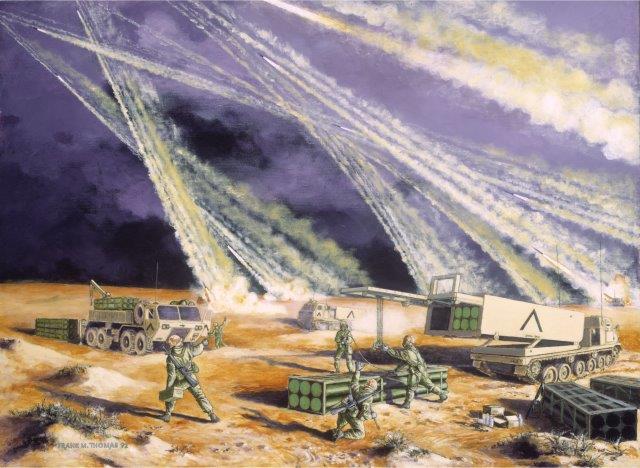 "Steel Rain:" The Army National Guard in Desert Storm by Frank M. Thomas for the state of Oklahoma, 1991.
"Steel Rain:" The Army National Guard in Desert Storm by Frank M. Thomas for the state of Oklahoma, 1991.
On 2 August 1990, the forces of Iraq invaded Kuwait. From the first days of the world's response to the Iraq's invasion, Army National Guard soldiers reacted, initially as volunteers, and later as members of mobilized units. During this period, the Guard went through its largest mobilization since the Korean War.
The response of Guard soldiers and their families vindicated the trust that the nation had placed in them. Many supports-transportation, quartermaster, command and control headquarters, military police, medical and others answered the call and served in the desert, providing less-heralded but very necessary functions. More than 62,000 Army National Guard soldiers were mobilized, and of these, nearly 39,000 deployed to Southwest Asia.
Tensions erupted into a fighting war on 17 January 1991, when Allied air forces initiated a devastating air campaign. The scope of the conflict widened in February when, after a series of skirmishes and battles along the borders of Saudi Arabia, Kuwait and Iraq, the Allied ground offensive began. Six Army National Guard field artillery battalions supported the advance into Iraq.
One of these battalions, the 1st Battalion, 158th Field Artillery, Oklahoma Army National Guard, was armed with the Multiple-Launch Rocket System. Field artillerymen of this battalion supported the ground attack by firing salvos of Multiple-Launch Rocket System rockets into Iraq, and continued to support the massive ground offensive with responsive, accurate and devastating fire throughout the campaign. The Multiple-Launch Rocket System rockets were so deadly that the Iraqi soldiers called them "steel rain." The dedicated and selfless service of the Army National Guard in Operation Desert Storm carries on the 355-year National Guard mission of defense of the nation.
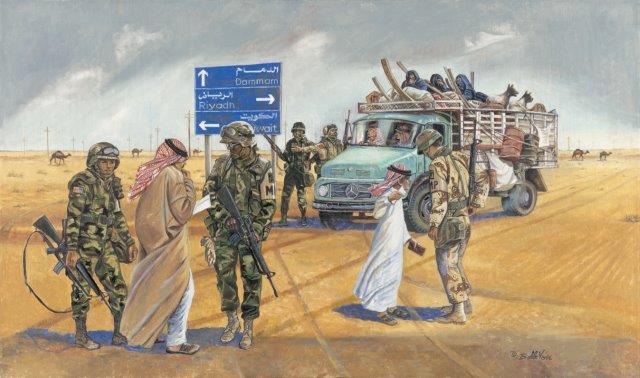 Capital Guardians in the Storm by Bobb Vann for the District of Columbia, 1991.
Capital Guardians in the Storm by Bobb Vann for the District of Columbia, 1991.
Military Police were one of the most heavily mobilized branches of the National Guard during Operations Desert Shield and Desert Storm. They processed and guarded tens of thousands of Iraqi prisoners of war captured during that short, victorious conflict, conducted security operations, maintained law and order, and controlled both military and civilian traffic.
Families of Bedouins carrying all their worldly possessions on an ancient truck were not an uncommon sight in the desert, and searching their vehicles could be a lengthy process. Thirty states - Alabama, Arizona, California, Colorado, Connecticut, Florida, Georgia, Iowa, Illinois, Kentucky, Louisiana, Maryland, Massachusetts, Michigan, Minnesota, Missouri, Mississippi, North Carolina, North Dakota, Nevada, New York, Ohio, Oklahoma, Rhode Island, South Carolina, Tennessee, Utah, Virginia, Wisconsin and West Virginia - as well as the territory of Guam and the commonwealth of Puerto Rico all provided Military Police units during the war. But the contingent of military police from the District of Columbia, three companies and a battalion headquarters detachment, was particularly noteworthy given the size of the DC Guard.
When included with the Transportation company and Medical hospital also mobilized for the war, some 60 percent of the DC Army National Guard was deployed to Southwest Asia. Headquarters and Headquarters Detachment, 372nd Military Police Battalion, was attached to the 14th Military Police Brigade served in a combat support role within VII Corps. It commanded both active Army and Army National Guard MP companies. A proud unit composed largely of African-Americans, it traces its history back to 1802 and carries campaign streamers from the War of 1812, Mexican War, Civil War, Spanish-American War, and both World Wars. For its participation in Operation Desert Storm, the 372nd MP Battalion added two more campaign streamers to the seventeen already displayed on its battalion colors.
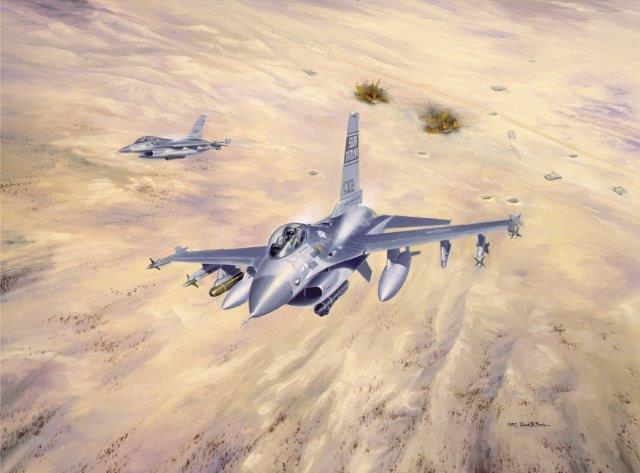 Swamp Foxes by David Poole for the state of South Carolina, 1991.
Swamp Foxes by David Poole for the state of South Carolina, 1991.
On 2 August 1990, the armed forces of Iraq invaded Kuwait. America's answer to the Iraqi aggression proved that the Air National Guard was a full partner in the total U.S. Air Force as they responded with speed and power as part of the overall American and Allied deployment.
Air National Guard transports, refuelers, reconnaissance aircraft, fighters, communication and other units were part of the mailed fist that struck the Iraqis in January and February 1991. A new era in warfare began on 17 January 1991 when the Allied air forces initiated the air portion of Operation Desert Storm, a 37-day air offensive which overwhelmed the Iraqi armed forces and opened the way for the ground force attack.
The F16A's of the South Carolina Air National Guard's 169th Tactical Fighter Group, the "Swamp Foxes," struck early and often, playing a crucial role in the devastating allied air offensive. "Swamp Fox" F16A fighters left Al Kharj Air Base, Saudi Arabia on 5 February 1991 on day 20 of the air offensive. Some of the F16's were armed with "Maverick" air-to-ground missiles designed to destroy pinpointed targets. When this sortie was completed, the pilots reported five Iraqi tanks and one truck destroyed. The Air National Guard's contribution to the success of Operation Desert Storm carries on a tradition of service to both state and nation.
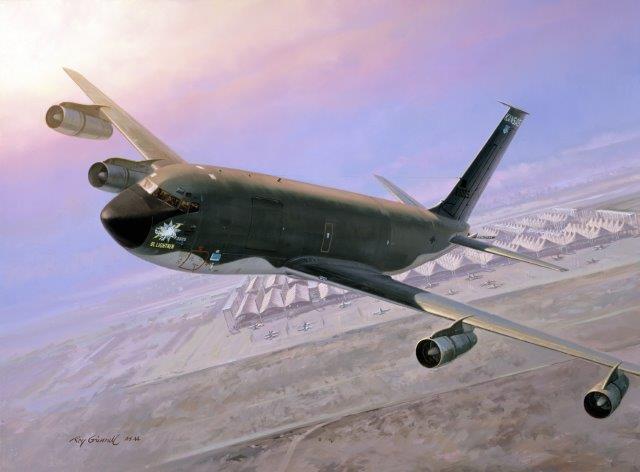 Tankers at Jeddah by Roy Grinnell for the state of Kansas, 1991.
Tankers at Jeddah by Roy Grinnell for the state of Kansas, 1991.
A KC-135E tanker from the Kansas Air National Guard's 190th Air Refueling Group returns to King Abdul Aziz International Airport at Jeddah, Saudi Arabia on January 17, 1991, the opening day of the air campaign against Iraq.
Tankers played crucial roles in three different aspects of Operations Desert Shield and Desert Storm: the rapid deployment of large coalition military forces to the region, the sustained readiness of the forces, and the use of forces in large and complex combat operations. Elements of the 190th had been the first tankers to arrive at Jeddah in August 1990. They played a lead role in the 1709th Air Refueling Wing (Provisional). That composite organization represented a new way of doing business by temporarily blending the three major organizational components of the Total Air Force for the duration of the 1990-1991 Persian Gulf crisis.
The wing consisted of Air Guard tankers from several states as well as those from the Air Force Reserve and the active Air Force. The 1709th was one of the largest aerial tanker task forces ever assembled. Its intense tanker operations were conducted around-the-clock. Elements of all 13 tanker units then in the Air Guard's force structure participated in the 1990-1991 Persian Gulf crisis. The critical support which Air National Guard tankers provided during operations Desert Shield and Desert Storm was one of the keys to the Allied air campaign. Those tankers carried on a long Air National Guard tradition of dedicated service to the states and nation.
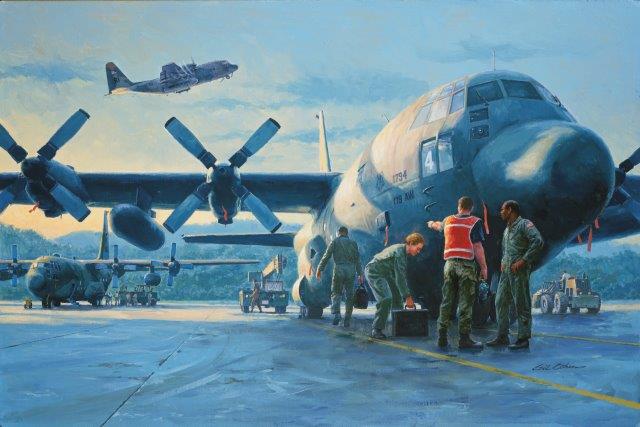 Coronet Oak by Gil Cohen for the states of Ohio, Wyoming and Rhode Island, 1997.
Coronet Oak by Gil Cohen for the states of Ohio, Wyoming and Rhode Island, 1997.
Members from the 179th Airlift Wing, Ohio, and the 130th Airlift Wing, West Virginia prepare for additional missions while a C-130 from Rhode Island's 143rd Airlift Wing takes off from Howard Air Force Base. Coronet Oak (originally Volant Oak), the Air National Guard's longest running airlift operation, began in October 1977.
It rotated portions of Air National Guard and Air Force Reserve C-130 units to Panama on short tours of active duty to meet the theater airlift requirements of the United States Southern Command in Latin America. Relying on volunteers and Lockheed's versatile C-130 Hercules transport, Coronet Oak also marked the growing participation of women and minority aircrew members in the Air Guard and Air Force Reserve.
Virtually the entire C-130 airlift community in the Air Guard and Air Force Reserve participated in Coronet Oak. The operation was moved to Puerto Rico in 1999 when U.S. military installations in Panama were closed.
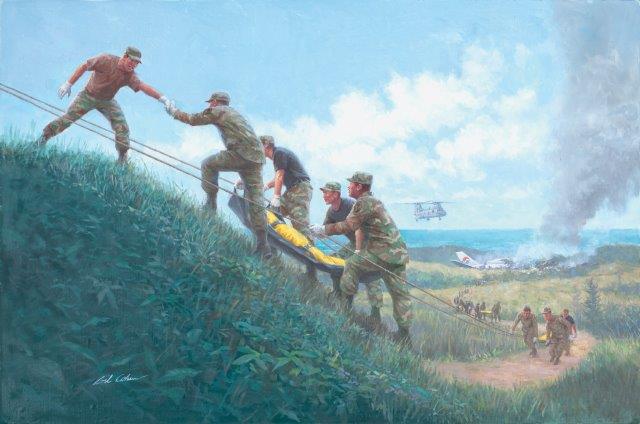 Tragedy in Paradise: Recovery of Flight 801 by Gil Cohen for the state of Guam, 1997.
Tragedy in Paradise: Recovery of Flight 801 by Gil Cohen for the state of Guam, 1997.
At approximately 1:45 am on August 6, 1997, Korean Airlines Flight 801 approached A.B. Won Pat International Airport in Agaña, Guam, en route from Seoul, South Korea. The Boeing 747-300 aircraft crashed in a jungle section of Nimitz Hill. The damaged fuselage caught fire and sparked an explosion.
Of the 254 passengers and flight crew on board the aircraft, 228 perished. The island’s remoteness from other U.S. territories made it inevitable that its National Guard would have to respond to a disaster of this size. Governor Carl T.C. Gutierrez called upon nearly 500 National Guard Soldiers and Airmen to support rescue and recovery operations. Operations at the crash site, already difficult due to the steep slope of the hillside and thick sword grass, were further complicated by a ruptured gas line and the large size of the debris field, as KAL 801 had broken up into multiple sections.
The Guam Territorial Area Command, the 1st Battalion, 294th Infantry, the 1224th Engineer Detachment, and the 254th Service Flight provided security, communication support, recovery and care of casualty and trauma victims, and much-needed crowd control. Guam’s National Guard did a highly commendable job in supporting territorial civil authorities in what was Guam’s worst aviation disaster. Governor Gutierrez commended the Soldiers and Airmen of the Guam National Guard. “I saw the real heroes,” he said, “the National Guard … the fire and police, and the other rescue workers who do this type of work on a daily basis. They are truly the heroes…” The Guam National Guard’s support to the recovery of KAL 801, its first territorial mission since being organized in 1981, demonstrated its professionalism as a military force. The readiness and dedication of this force is underscored by the motto of the Guam Army National Guard: “A’ Adahen I tano,” which translates from the native Chamorro language as “Guardians of the Land.”
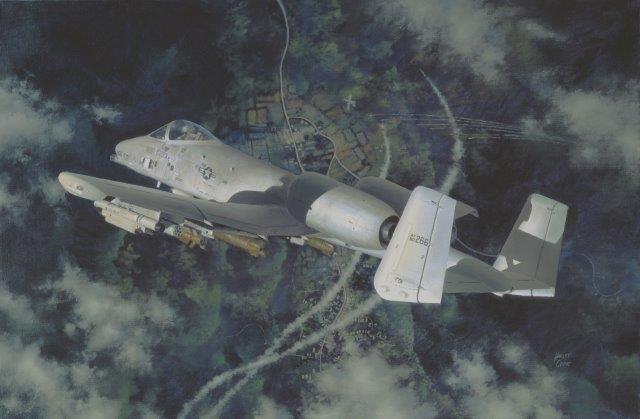 The Killer Bees by Harley Copic for the states of Massachusetts, Michigan and Idaho, 1999.
The Killer Bees by Harley Copic for the states of Massachusetts, Michigan and Idaho, 1999.
Flying from its main installation at Trapani Air Base, Sicily and a forward location at Taszar Air Base, Hungary, the A-10s of the 104th Expeditionary Operations Group (EOG) were known as the "Killer Bees." They belonged to a composite or "rainbow" Air National Guard (ANG) unit composed of personnel and aircraft from the 104th Fighter Wing at Barnes Air National Guard Base, Massachusetts, the 110th Fighter Wing at Battle Creek, Michigan, and the 124th Wing at Boise, Idaho.
The 104th EOG also included active duty Air Force members who were responsible for base operating support functions. The 104th EOG was formed as a temporary composite unit because no single ANG fighter wing possessed enough A-10s to meet the wartime requirements for Operation Allied Force, the war for Kosovo.
The unit flew 439 combat sorties expending 64 AGM-65 "Maverick" air-to-surface missiles, 539 MK-82 free-fall non-guided general purpose 500-pound bombs, 49 CBU-87 "Combined Effects Munitions," and over 14,300 rounds of 30mm ammunition while attacking enemy military convoys, armor, artillery, supply storage areas, and ammunition storage sites. Its pilots also flew combat search and rescue as well as airborne forward air control missions. The 104th EOG accumulated 3,300 flying hours in 45 days during may and June without losing a single pilot or aircraft. The employment of composite units was an increasingly important element of efforts by the ANG and the Air Force to adapt to the complexities of the post Cold War environment.
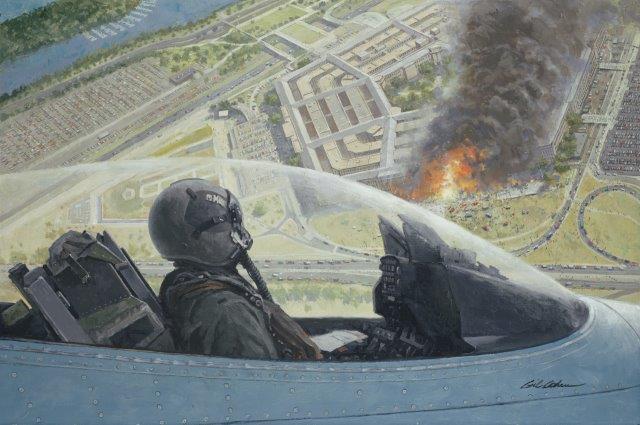 9-11 by Gil Cohen for the state of North Dakota, 2001.
9-11 by Gil Cohen for the state of North Dakota, 2001.
Launched from bases all over the United States, Air National Guard fighter and tankers moved quickly to protect America from further attacks on September 11, 2001. That morning 19 terrorists employed four hijacked airliners to destroy the World Trade Center in New York City and severely damage one section of the Pentagon.
The attacks, which were executed by a shadowy radical Islamic group known as al-Qaeda, killed some 3,000 people during the bloodiest terrorist assault in U.S. history. American Airlines Flight 77, which had just taken off from Dulles International Airport in Northern Virginia on a flight to Los Angeles, was seized by al-Qaeda terrorists and crashed through the Pentagon’s western wall at 9:37 a.m. North Dakota’s 119th Fighter Wing was stationed at the North American Aerospace Defense Command site on Langley AFB, Virginia. Shortly after the attack the 119th’s F-16 fighters established a combat air patrol over the nation’s capital.
In addition to all the passengers aboard Flight 77, 125 people inside the Pentagon were killed and over 600 others were injured seriously enough that they had to be transported to local hospitals. The North Dakota Air Guardsmen were joined that day by F-16s from the District of Columbia’s 113th Wing, based at Andrews AFB, Maryland and Virginia’s 192nd Fighter Wing from Richmond, as well as active duty Air Force and Navy fighters. Those fighter pilots were under orders to use deadly force if necessary to protect the nation’s capital from further attacks.
Within 24 hours of the terrorist attacks, 34 ANG fighter units across the country had launched aircraft. Fifteen of the units flew 179 combat air patrols, presidential escorts, and Federal Emergency Management Agency support missions. In addition, ANG tanker, airlift and rescue units flew scores of sorties that day. Hundreds more Air Guard personnel from various support fields including chaplain services, civil engineering, combat communications, medical and security forces were either activated or notified to stand-by for emergency duty. The majority of Air Guardsmen involved in responding to the 9/11 national emergency were traditional members of their units who volunteered to help defend their country on that terrible day.
Continuous combat air patrols were maintained over Washington, DC and New York City until the spring of 2002. The bulk of those missions, conducted under the auspices of Operation Noble Eagle, were flown by Air Guard pilots. Ironically, one result of the terrorist attacks was the saving of the continental air defense mission. It had been viewed as a fading post Cold War “sunset mission” by some senior military officers and high level government officials, but the attacks of 9/11 inspired a major effort to build a coherent homeland defense system for the continental United States against terrorism and other threats.
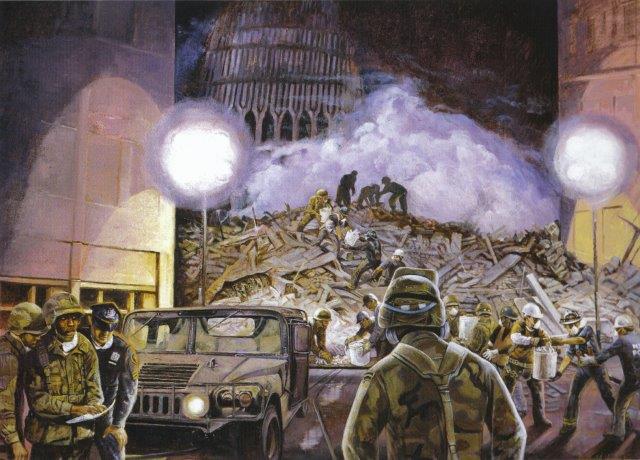 Ground Zero by Bobb Vann for the state of New York, 2001.
Ground Zero by Bobb Vann for the state of New York, 2001.
In New York City, the beautiful morning of Tuesday, September 11, 2001, was transformed instantly at 8:46 a.m., when a hijacked airliner crashed into the North Tower of the World Trade Center. When a second airliner struck the South Tower 16 minutes later, what many assumed was a terrible accident was quickly shown to be a deliberate act of terrorism. Within an hour shock turned to horror as first one, then the other, of the Twin Towers collapsed.
Together with a third plane that struck the Pentagon and a fourth that crashed into a Pennsylvania field as passengers struggled with the terrorists, nearly 3,000 Americans perished that morning. Many members of the New York National Guard did not wait for a formal mobilization order, but rushed instantly to their armories. Closest were three battalions from the 3rd Brigade, 42nd Infantry Division: the 1st Battalion, 101st Cavalry from Staten Island; the 1st Battalion, 258th Field Artillery from Queens; and the 1st Battalion, 69th Infantry, headquartered in Manhattan a little over two miles north of what would quickly become known as "Ground Zero."
Also responding were B & C Companies of the 1st Battalion, 105th Infantry and New York's 2nd Civil Support Team (Weapons of Mass Destruction), which sampled the air for chemical, biological, or radiological elements. As Air Guard fighters circled above Manhattan, New York Guard members set to work, with generous assistance from neighboring states. Their most important mission was to cordon and secure much of lower Manhattan while others cleared Ground Zero, but in the first days and nights after the attack, it was common for Guard men and women to work in "bucket brigades," removing debris by hand while searching for survivors, as other Guard members provided transportation, engineering, and medical support and escorted residents to their homes.
The 69th Infantry's armory was turned into an assistance center for thousands of family members seeking word of lost loved ones. Guard members on state active duty provided security at critical infrastructure sites-bridges, train stations, power plants-in some cases for years after the attacks. By November 2001, most support functions had been handed back to other agencies. But when the headquarters of the 42nd Infantry Division deployed to Iraq in 2004, the image of 9/11 remained strong, and "Rainbow-Never Forget" became the division's unofficial motto, recalling their presence at the first battle in the Global War on Terrorism.
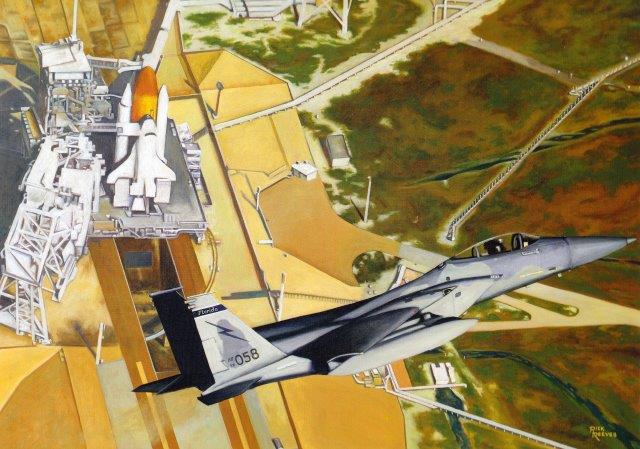 Operation Noble Eagle 2001 by Rick Reeves for the state of Florida, 2001.
Operation Noble Eagle 2001 by Rick Reeves for the state of Florida, 2001.
Operation Noble Eagle, the military's Homeland Defense mission, officially began on September 12, 2001, the day after the attacks on the World Trade Center and the Pentagon. Air National Guard, U.S. Air Force and U.S. Navy fighters began flying combat air patrol missions over major cities and critical infrastructure locations such as power plants, bridges, airports, and port facilities across the United States.
These sites were covered on a continuing basis for several months before a gradual phase down of Noble Eagle operations began. One of the many locations covered by Operation Noble Eagle was the space shuttle launch facility at the Kennedy Space Center. Protecting the space shuttle Endeavour, this Florida Air National Guard F-15 from the 125th Fighter Wing in Jacksonville is just one of the hundreds of military aircraft protecting the nation's assets on a daily basis.
The Endeavour, the last space shuttle built for NASA and the last to be retired, flew 25 missions during its 20 years of service. All of the space shuttles that occupied the launch pad from September 2001 to the end of the space shuttle era were protected under Operation Noble Eagle. Security in the air was very important just as it was on the ground. To fill other roles under Operation Noble Eagle, a total of 35,000 military men and women were called upon to participate. Among them were National Guard civil support teams, used primarily at Ground Zero and the Pentagon in the roles of rescue and recovery.
Many of the 35,000 were utilized to provide additional security at locations such as airports and other major transportation hubs across the country. Military aircraft in support of Operation Noble Eagle have flown more than 61,000 sorties, the bulk of which were flown by the Air National Guard. During these combat air patrols, fighters have been diverted more than 2,350 times to investigate suspicious aircraft.
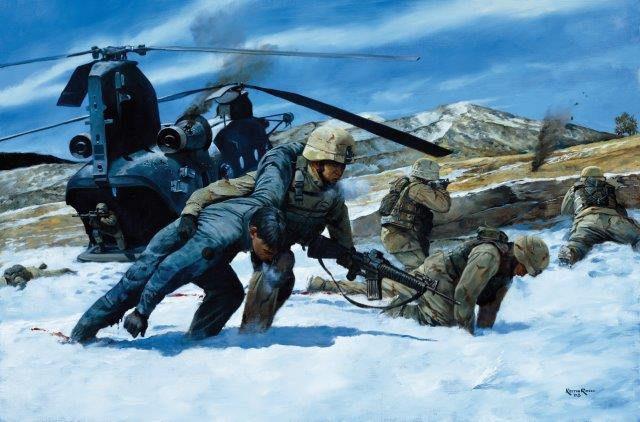 The Battle of Takur Ghar by Keith Rocco for the state of Kentucky, 2002.
The Battle of Takur Ghar by Keith Rocco for the state of Kentucky, 2002.
Operation Enduring Freedom, the military action against Taliban and al-Qaida forces in Afghanistan, was the catalyst for the largest mobilization of Air National Guard personnel since the Korean War.
It also marked the first time that Air National Guard ground units, particularly pararescue personnel and air combat controllers, were used to support joint ground combat operations. As part of Enduring Freedom, in March 2002 a joint military operation named "Anaconda" was mounted in Paktia province to surround and defeat Taliban forces hiding in the area. On the third day of Operation Anaconda an Army MH-47E Chinook helicopter was fired upon as it attempted to land on a ridge on Takur Ghar mountain.
Taking heavy fire, the helicopter lurched and attempted to take-off to extricate itself from the field of fire. When the Chinook lurched, one of the Navy SEALs on board, Petty Officer First Class Neil C. Roberts, fell from the rear ramp. Too damaged to return for Petty Officer Roberts, the Chinook landed further down the mountain. A second MH-47E attempted to land and rescue Roberts, but it too was fired upon and forced to leave the immediate area. The third MH-47E to attempt a landing on what became known as Roberts’ Ridge was hit with automatic weapons fire and rocket-propelled grenades while still 20 feet in the air.
The helicopter, containing an Army Ranger Team and Technical Sergeant Keary Miller, a Combat Search and Rescue Team Leader from the 123d Special Tactics Squadron, Kentucky Air National Guard, hit the ground hard. Within seconds, one helicopter crewman, the right door gunner, was killed, as were three Army Rangers. The 17-hour ordeal that followed would result in the loss of seven American lives, including Petty Officer Roberts. Technical Sergeant Miller not only managed to drag the wounded helicopter pilot to safety, but also orchestrated the establishment of multiple casualty collection points.
In between treating the wounded, Miller set up the distribution of ammunition for the Army Rangers who were taking the fight to the enemy. For his extraordinary life-saving efforts while putting himself in extreme danger under enemy fire, Technical Sergeant Miller was awarded the Silver Star by the U.S. Navy, one of the few members of the Air National Guard to be so honored.
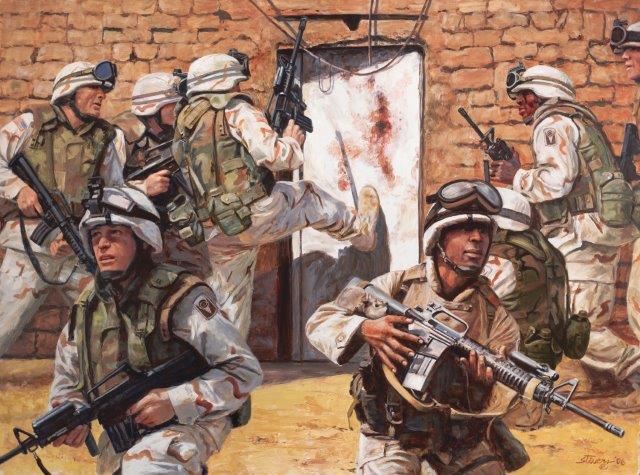 Capture at Ar Ramadi by Don Stivers for the state of Florida, 2003.
Capture at Ar Ramadi by Don Stivers for the state of Florida, 2003.
The Florida Army National Guard's 1st Battalion, 124th Infantry, along with the regiment's second and third battalions, was mobilized in January 2003 for service in Operation Iraqi Freedom. Following thirty-eight days of post mobilization training at Fort Stewart, GA, the unit deployed to Jordan where it initially served as the security force at Prince Hassan Air Base, a forward operating base for U.S. Special Operations Forces and A-10 aircraft of the United States Air Force.
In late April 2003, the battalion was attached to the 3rd Armored Cavalry Regiment and deployed into Iraq by air and ground assault convoy. After consolidation at Al Asad Air Base, Iraq, it moved to Ar Ramadi, the provincial capital of Al Anbar Province, where it was assigned an area of operation consisting of approximately 2,400 square kilometers and more than 350,000 Sunni Iraqi inhabitants. While there, they provided local security and assisted in the reestablishment of the Iraqi Police and Ministerial Guard forces.
The unit also conducted cordon and search operations. During one of these sweeps through the outskirts of Ar Ramadi on August 20, 2003, members of the 1-124 Infantry captured Salem Musa Ijly. Also known as Abu Inas, Ijly was a Jordanian national and member of al-Qaida, who was facilitating weapons smuggling through Iraq into Jordan and maintaining weapons stockpiles in Ar Ramadi. He was also linked to a plot to assassinate Jordanian King Hussein. During its deployment, the battalion captured 511 enemy combatants; recovered 2,399 small arms, 221 mortar tubes, 4,258 mortar round and 43 RPG launchers; captured, defused or engaged 715 improvised explosive devices; processed 7,422 detainees; and, disbursed more than $1.3 million in aid for repair or construction of numerous buildings, to include two hospitals, 67 schools and 52 mosques.
The 1-124 Infantry received the Valorous Unit Award for extraordinary heroism in operations. Soldiers of the unit were presented 65 Bronze Stars (two with “V" device), 379 Army Commendation Medals (13 with “V" device), and 63 Purple Hearts. Despite serving 291 continuous days in combat operations, the unit brought home every Soldier who deployed with it.
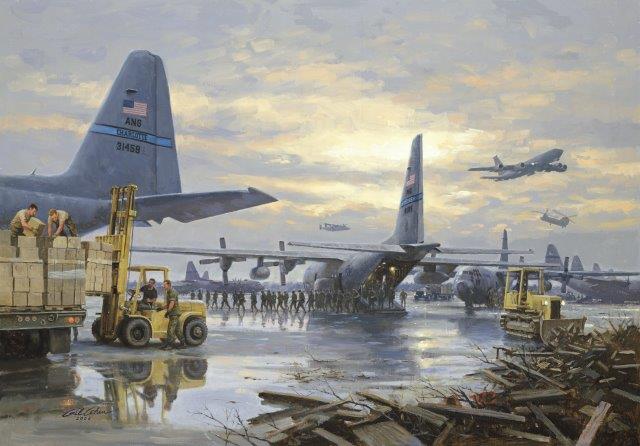 In Katrina's Wake by Gil Cohen for the state of North Carolina, 2005.
In Katrina's Wake by Gil Cohen for the state of North Carolina, 2005.
Hurricane Katrina made landfall in Louisiana and Mississippi on August 29, 2005 causing one of the worst natural disasters in the history of the United States. Air and Army National Guardsmen from across the country, along with state and local emergency responders and members of the active duty armed forces, poured into the Gulf Coast region to participate in a massive humanitarian relief effort.
The entry point for much of the National Guard’s relief operations in Louisiana was the New Orleans Naval Air Station located immediately south of the Crescent City in the suburb of Belle Chasse. Beginning on September 1, 2005, Air National Guard C-130s and KC-135s airlifted equipment, supplies, food and military personnel into the airfield and began evacuating sick and injured civilians.
Army National Guard helicopters and fixed wing aircraft also participated in relief operations from that installation. In addition to aircrews and planes, Air Guard rescue personnel and equipment as well as combat controllers, security forces, and civil engineering personnel deployed to Belle Chasse. They immediately began conducting rescue operations and building up the base infrastructure to support the huge influx of troops to the devastated Gulf Coast. Most of the National Guardsmen who deployed to the region, including those at the Naval Air Station, remained in state status under the legal control of their governors which enabled them to provide law enforcement support in affected areas when required.
They deployed in accordance with Emergency Management Assistance Compacts that had been developed between many states well before Hurricane Katrina struck. By September 8, 2005, over 51,000 National Guardsmen were helping people along the Gulf Coast deal with the terrible devastation inflicted on them by Hurricane Katrina, making this the largest deployment for a domestic emergency in the history of the National Guard.
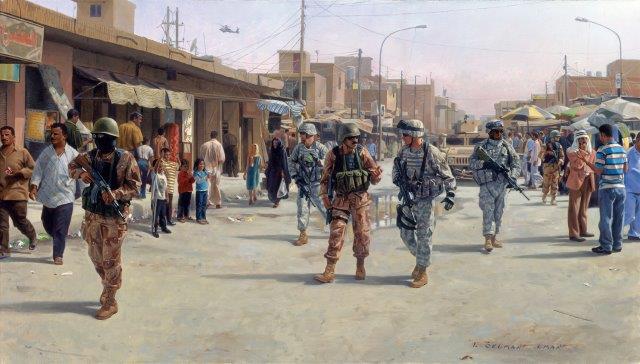 Martyrs' Market by Larry Selman for the state of Georgia, 2005.
Martyrs' Market by Larry Selman for the state of Georgia, 2005.
In December 2004, the 48th (Lightning) Brigade, Georgia Army National Guard, mobilized for Operation Iraqi Freedom III. This heavy brigade was composed of 4,600 soldiers, which included 2,600 Georgians and additional Army National Guard soldiers from Alabama, Illinois, Missouri, Maryland, Rhode Island, and Puerto Rico.
The 48th (Lightning) Brigade, the largest brigade to deploy in Operation Iraqi Freedom to date, was tasked with creating Military Transition Teams (MiTT) to advise and train the Iraqi Army. The 48th Brigade operated as six MiTTs with their Iraqi Army counterparts, within the districts of Mahmudiya, Lutifiyah, and Yusufiyah. Located 20 miles south of Baghdad, the district of Mahmudiya is the sectarian fault line of a geographic area composed of approximately 60 percent Shi'a and 40 percent Sunni Muslims.
Largely destroyed during heavy sectarian fighting, the marketplace in Mahmudiya (nicknamed the “Martyrs' Market”) was rebuilt as a joint US and Iraqi effort to help stabilized relations between the two religious groups. The 48th Brigade operated six MiTTs within the 6th Iraqi Army. MiTT #1 consisted of 15-20 volunteer soldiers drawn from units within the 48th Brigade. Their mission was to help make the 1st Battalion, 4th Brigade, 6th Iraqi Army Division technically and tactically proficient in conducting independent counterinsurgency operations.
The 48th Brigade conducted increased US-Iraqi joint operations during early October to promote security for the upcoming Iraqi constitution referendum vote. Their efforts allowed Iraqi voters to ratify the proposed Iraqi constitution on October 15, 2005; public elections were held two months later with no significant insurgent attacks. In June 2006, the 48th Brigade returned to Georgia, where it remains an integral part of the nation's line of defense.
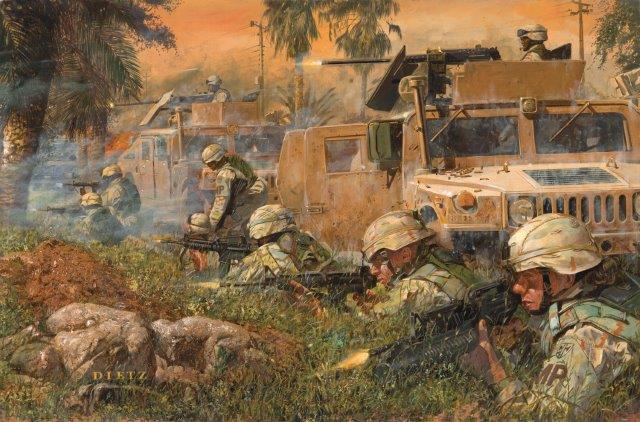 RAVEN 42 by James Dietz for the state of Kentucky, 2005.
RAVEN 42 by James Dietz for the state of Kentucky, 2005.
It was Palm Sunday, and two U.S. convoys were about to converge at a crossroads 30 miles south of Baghdad. The two had almost met when they were struck by one of the largest groups insurgents ever to attack a convoy. The stretch of road was guarded by the 617th Military Police Company, from Richmond, Kentucky. Mobilized on October 2, 2004, once in Iraq the MPs organized into squads.
The 4th Platoon's 2nd Squad, 10 men and women in three armored High-Mobility Multipurpose Wheeled Vehicles, operated as "Raven 42." Raven 42 had already skirmished with the insurgents, so squad leader SSG Timothy Nein had drilled them intensively. Both convoys were under heavy attack and the insurgents were closing in when Raven 42 heard the firing. The three HMMWVs returned fire as they raced to an access road, where they too came under heavy fire. As a round knocked his gunner unconscious, SSG Nein turned and saw 28 men getting out of seven cars near a berm.
With two MPs wounded already, Nein called for reinforcements and air support - and went on the offensive. Many of the enemy were firing from a nearby trench. Nein called to his vehicle commanders, SGTs Leigh Ann Hester and Dustin Morris, firing from behind the berm, to bring an M203 grenade launcher. Hester was closer; under fire, she raced for the weapon and jumped into the trench. With Morris covering, Nein and Hester moved down the trench. The M203 was ineffective at such close range, so the two alternated lobbing grenades and firing their M48. Minutes later Nein and Hester were finished clearing the trench; 24 insurgents were dead, 9 wounded and one captured.
Three contractor drivers from the convoys were dead, and handcuffs found on enemy corpses indicated plans to kidnap more. Later this spring, Specialists William Haynes, Casey Cooper and Ashley Pullen received Bronze Stars for valor. Medic Jason Mike received the Silver Star, as did SGT Hester and SSG Nein. Pullen and Hester were the first women in U.S. history to receive medals for valor in actual combat; Nein's Silver Star was later upgraded to the Distinguished Service Cross. All of the men and women of Raven 42 exemplify the great combat heritage of the National Guard.
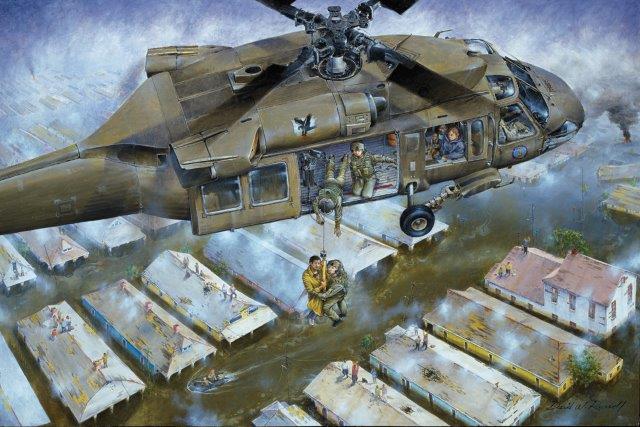 When the Levees Broke by David W. Russell for the state of Arkansas, 2005.
When the Levees Broke by David W. Russell for the state of Arkansas, 2005.
Hurricane Katrina, which made landfall on August 29, 2005, was not the strongest storm to ever hit American shores. Yet it caused over 1,600 deaths and rendered the most property damage in U.S. history after flood walls in New Orleans gave way and left 80% of the Crescent City and many of the surrounding parishes under water.
The response to this unfathomable disaster was an unprecedented mobilization of the National Guard for a domestic emergency. Soldiers and Airmen from all 50 states, the territories of Guam and the U.S. Virgin Islands, the Commonwealth of Puerto Rico and the District of Columbia deployed in record time in support of their Gulf Coast neighbors. The National Guard responded in record numbers, despite a massive overseas deployment of some 79,000 personnel in support of the Global War on Terror.
Guard forces were rescuing people within four hours of Katrina’s landfall. More than 11,000 Soldiers and Airmen were involved in rescue operations on August 31. More than 6,500 Guard men and women were on site in New Orleans by September 2. At the peak of the Guard’s involvement on September 7, over 51,000 Guard members were mobilized for Katrina in a Title 32, federally-funded but state-controlled status. The number was three times greater than the previous record response for a natural disaster - nearly 17,000 following the 1989 Loma Prieta earthquake that shook San Francisco. This rapid response would not have been possible without the proliferation of Emergency Management Assistance Compacts between the states which enabled Governors to call on one another for aid in times of need.
In the early stages of rescue operations, the most visible sign of relief was the 146 Army National Guard helicopters in the air rescuing stranded citizens, like the UH-60As from the Arkansas Army National Guard’s Detachment 1149th Medical Company (Air Ambulance). Over 17,000 Gulf Coast residents – 4,200 in New Orleans alone – along with many pets, were saved by Guard air and watercraft. Air Guard transport planes and Army Guard trucks also evacuated more than 70,000 residents. In the month of September, the Guard delivered over 5.5 million individual food rations, over 7 million liters of water and 12 million pounds of ice. For residents of Louisiana, Mississippi, Alabama, and Texas, Guard members cleared debris and provided communications, security, medical care, and most of all – hope
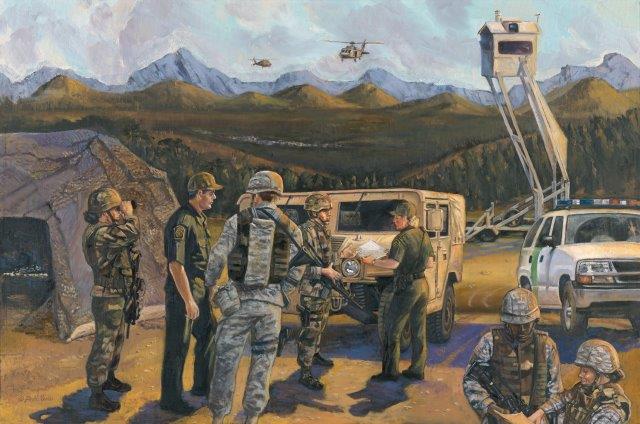 Operation Jump Start by Bobb Vanni for the states of Arizona, California, New Mexico and Texas, 2006.
Operation Jump Start by Bobb Vanni for the states of Arizona, California, New Mexico and Texas, 2006.
In 1916, following the raids of Mexican bandit/revolutionary Pancho Villa into New Mexico and Arizona, the entire National Guard, more than 150,000 strong, was federalized for a year and stationed along the 2,000 mile Mexican border in California, Arizona, New Mexico, and Texas. Ninety years later, tens of thousands of Army and Air National Guard members returned to the same border, to perform a mission which, considering the timespan, was remarkably similar.
By 2006, migrants from Central America and Mexico, drawn by a booming U.S. economy, were crossing the border into the United States in unprecedented numbers. Construction of a fence along the California-Mexico border had driven the migrants eastward, and southern Arizona, large stretches of it unpopulated, saw hundreds of crossings each day. Governor Janet Napolitano called out the Arizona National Guard to assist the beleaguered Border Patrol, and governors of the three other border states joined her in calling on the Federal government to enforce the nation’s immigration laws and stem the tide of illegal activity along the border.
On May 15th, 2006, President George W. Bush announced the initiation of "Operation Jump Start," a plan to use National Guard troops to assist the Border Patrol in restoring order to the region. The troops would operate under the terms of Memorandums of Agreement signed by the four border-state governors. While the troops would not participate directly in law enforcement or in apprehending migrants, they would be armed. For the next two years, up to 6,000 National Guard soldiers and airmen at a time rotated in contingents throughout the Southwest. They monitored electronic surveillance systems, manned isolated outposts, and flew helicopters equipped with sophisticated radar systems, their presence freeing up hundreds of Border Patrol agents to perform the actual apprehension of illegal migrants and drugs.
Guard engineers built dozens of roads, particularly in the mountains of southeastern Arizona, increasing the Border Patrol’s mobility and earning the gratitude of its agents, who still patrol this rugged country on horseback as they have done since the 1920s. When Operation Jump Start concluded in July 2008, over 30,000 Army and Air Guard personnel from units in all 54 states, territories, and the District of Columbia had served on the border. As in 1916-17, the presence of the National Guard along the border made a difference, and the number of migrant apprehensions decreased after their deployment.
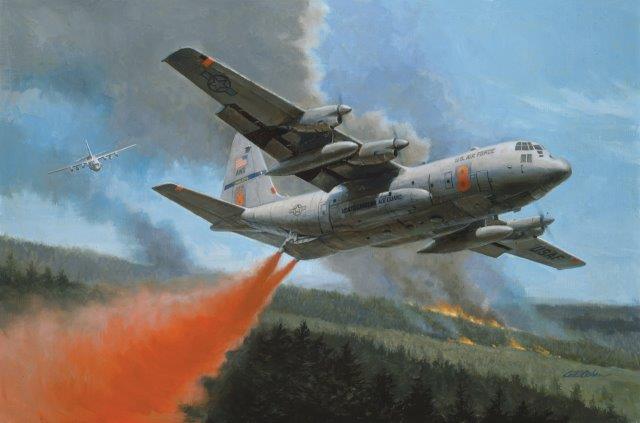 Quenching the Flames by Gil Cohen for the state of North Carolina, 2007.
Quenching the Flames by Gil Cohen for the state of North Carolina, 2007.
One of two Modular Airborne Firefighting System (MAFFS) equipped C-130 Hercules aircraft from the 145th Airlift Wing, North Carolina Air National Guard, lays down a blanket of flame-retardant liquid over a forested area in Southern California. The fires, stoked by 100 mph Santa Ana winds, were categorized as a major disaster.
The results were more than 300,000 people driven from their homes and nearly 500,000 acres of woodlands consumed in 12 counties. Also deployed to Southern California were two MAFFS equipped C-130 s from the 153rd Airlift Wing, Wyoming Air National Guard. The four Air National Guard C-130s, staged at Naval Air Station, Point Mugu, flew more than 40 missions in the first week of operations. The MAFFS, owned by the U.S. Forest Service, is a fire-suppressant apparatus that is loaded into the C-130's cargo area.
Consisting of a series of five pressurized tanks, the MAFFS can hold 3,000 gallons of flame-retardant liquid that is dropped along the leading edge of a fire to block the spread of flames. Flown on Air National Guard and Air Force Reserve C-130 aircraft, the aircrews require special training to fly these civil support missions. MAFFS crews are buffeted by thermal gusts, wind, and smoke as they drop their payload while flying between 150 and 200 feet above the ground. Since 1974, the MAFFS has saved land, lives, and property from wildfires in the U.S. and abroad. Currently there are three Air National Guard C-130 units capable of operating MAFFS. In addition to the 145th AW and the 153rd AW, the 146th AW, California Air National Guard, also flies MAFFS-equipped C-130s. These units continue to stand at the ready to support civil emergencies.
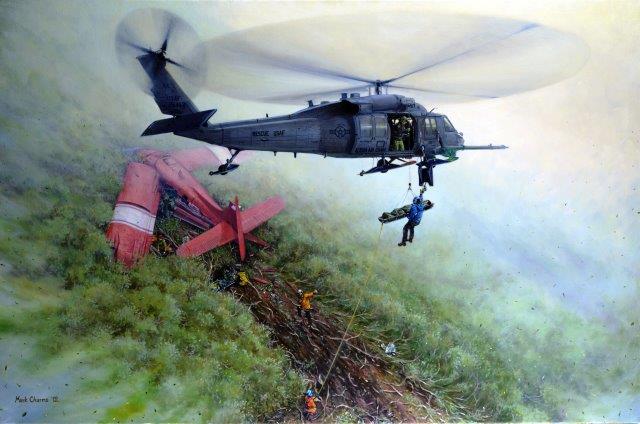 Midnight Sun Guardians: “So That Others May Live” by Mark Churms for the state of Alaska, 2010.
Midnight Sun Guardians: “So That Others May Live” by Mark Churms for the state of Alaska, 2010.
On August 9, 2010, former Alaska Senator Ted Stevens and eight other passengers flew from Nerka and Aleknagik Lakes on the southeast coast of the state. Nearby bush pilots reported a crash, yet poor weather visibility prevented rescue operations to commence that night. Two Good Samaritans spotted the crash from the air.
At about 9:00 pm, the 176th Wing, Alaska Air National Guard, based at Joint Base Elmendorf-Richardson in Anchorage, was notified. The next day, an attempt was made to land the helicopter, but weather conditions twice postponed the flight. Survivors would wait about 18 hours. Senator Stevens, three passengers, and the pilot. Four others survived, but the inclement weather made care difficult. The rescue operation involved three rescue squadrons assigned to the 176th Wing: the 210th Rescue Squadron flew HH-60Gs; the 211th Rescue Squadron flew the HC-130Ps that refueled the HH-60s and provided airborne command and control during the rescue operation; and pararescuemen of the 212th Rescue Squadron recovered victims.
The entire sequence of events lasted through August 11. The rugged state of Alaska requires specialized equipment and well-trained personnel. The persistence of the pilots and crew of the Squadron rendering aid stood out, as did the Good Samaritans. Ironically, the Alaska Air National Guard’s Search and Rescue mission started because of legislation supported by Senator Stevens. Since 1990, they have been the busiest Combat Search and Rescue Squadrons in the U.S. Air Force. In over 5,000 missions, they have saved nearly 2,000 lives and rescued hundreds. The rugged state of Alaska requires specialized equipment and well-trained personnel.
The persistence of the pilots and crew of the Squadron rendering aid stood out, as did the Good Samaritans. Ironically, the Alaska Air National Guard’s Search and Rescue mission started because of legislation supported by Senator Stevens. Since 1990, they have been the busiest Combat Search and Rescue Squadrons in the U.S. Air Force. In over 5,000 missions, they have saved nearly 2,000 lives and rescued hundreds. Through their dedication to this mission, the 176th Wing of the Alaska Air National Guard exemplifies its own motto: “So that others may live."